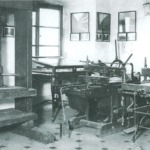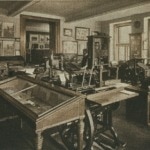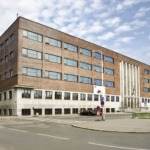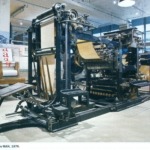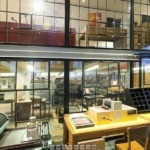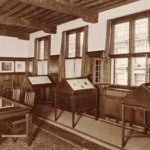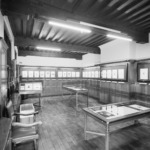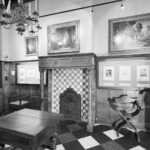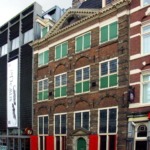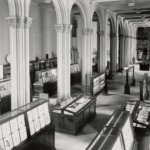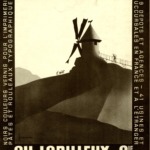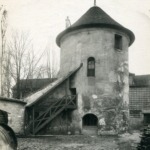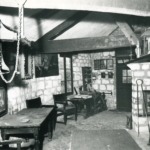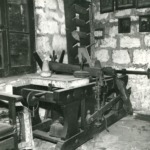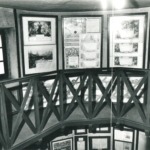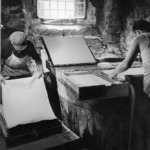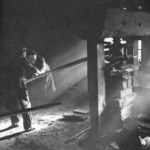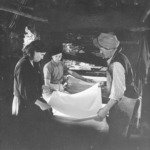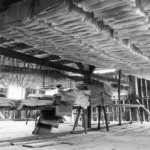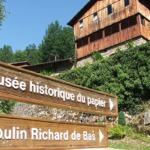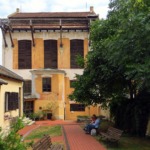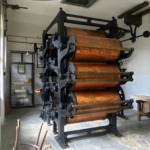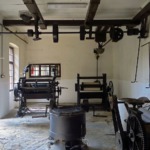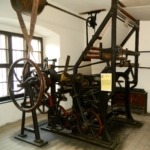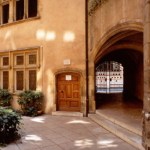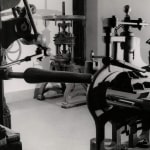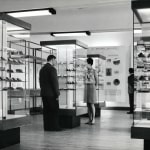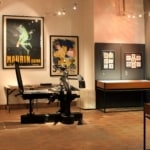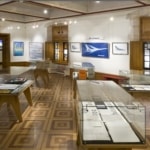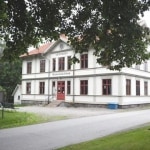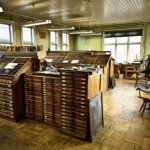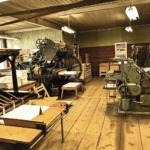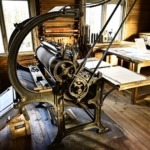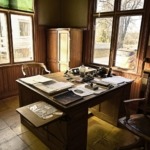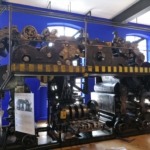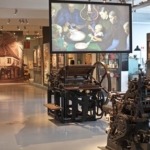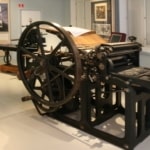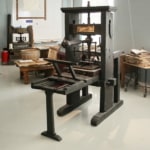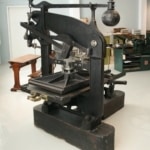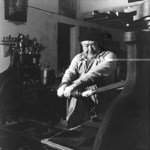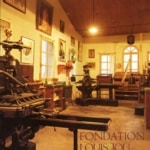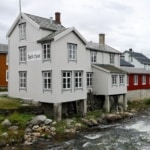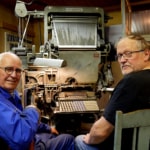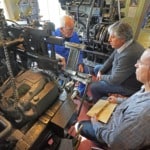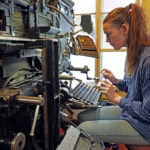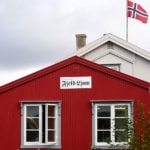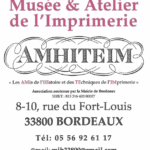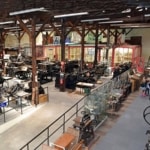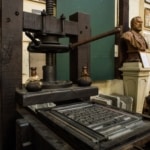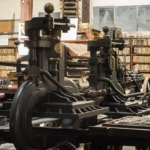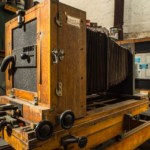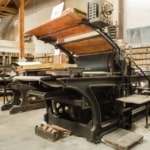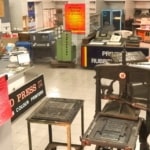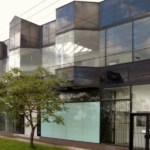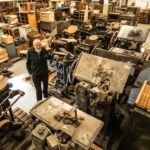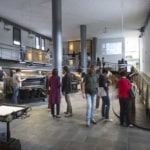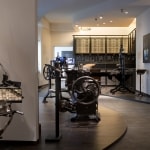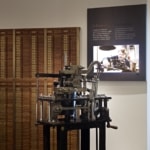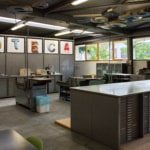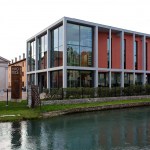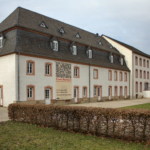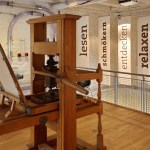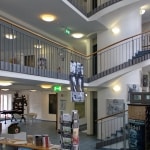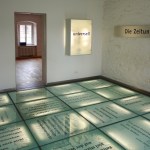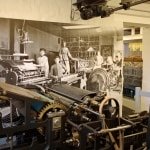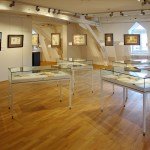A brief chronology of museums in the fields of printing and graphic communication
The following is a constantly growing list (300 or so at the last count) of the foundation dates of printing, book, paper, graphic design and other print-related museums. Many of them are still in existence today, sometimes after one or more changes of name or location. Others have disappeared, in which case closure dates are given when known (which is not often because closures are harder to track than openings). The list is intended as an evolving research tool for anyone interested in how the institutions of printing heritage have developed since the middle of the nineteenth century. If you wish the foundation date and a description of the origins and development of your organisation to be included in this list, or if you have any information about museums past or present which are not currently included, we would be very happy to hear from you.
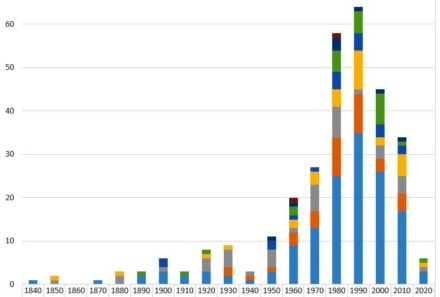 A graphic overview of the creation of printing and graphic heritage organisations, by sector of activity and by decade from the 1840s until the present day is to be found here.
A graphic overview of the creation of printing and graphic heritage organisations, by sector of activity and by decade from the 1840s until the present day is to be found here.
For all information, queries, corrections or additions please contact the editor of the timeline Alan Marshall here.
Links to the websites of many of the museums in operation today can be found in our Links section or by using our interactive Museum finder world map of printing museums.
Related articles on the AEPM website:
In the beginning… Some thoughts on early printing museums. by Alan Marshall
From their very beginnings European printing museums offered a remarkable diversity in their origins — libraries, private collections, commercial firms, trade associations — and in the motivations of their initiators.
Printing museums. What’s in a name? by Alan Marshall
What actually constitutes a printing museum. Just what kinds of organisations are we talking about?
The timeline
1843
Stanza dei punzoni (Biblioteca Palatina, Parma, Italy)
The nineteenth century saw the first public displays of objects illustrating printing techniques, more often than not side by side with books. Among the first was the Stanza dei punzoni (punches room) in the Biblioteca Palatina at Parma in Italy which, as early as 1843, offered a display of the typographical tools and printed editions of the celebrated punchcutter and printer Giambattista Bodoni (1740-1813). It was closed sometime before the Second World War, to reappear again in 1963 in the form of the Museo Bodoniano which, larger than its predecessor, brought together all the typographical material, archives and printed works of Bodoni.
1852
Meermanno Museum (now the Huis van het boek The Hague, Netherlands)
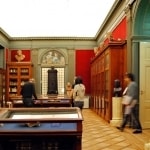 One of the very first museums in Europe to be dedicated specifically to printing heritage. It was born of a collector’s desire to share his collection and to assure its continued existence and was the brainchild of the Baron Willem Van Westreenen de Tiellandt (1783-1848) a rich bibliophile who, having no heirs, bequeathed his collection of 15,000 rare books to the Dutch State on condition that it be used to found a public museum to be installed in his mansion house which he also left to the State. It was the first time that a museum had been dedicated exclusively to exhibiting books in their own right rather than as a means of illustrating other subjects, the aim being to show how the book had evolved over the centuries, how it was designed, illustrated, printed and bound, and how the book and Gutenberg’s revolutionary printing process had contributed to the advancement of Western civilization.In line with the nature of its collections, the Museum Meermanno was international and not a museum of Dutch printing or of the Dutch book, the historiography of which would not be seriously undertaken until the closing decades of the twentieth century.
One of the very first museums in Europe to be dedicated specifically to printing heritage. It was born of a collector’s desire to share his collection and to assure its continued existence and was the brainchild of the Baron Willem Van Westreenen de Tiellandt (1783-1848) a rich bibliophile who, having no heirs, bequeathed his collection of 15,000 rare books to the Dutch State on condition that it be used to found a public museum to be installed in his mansion house which he also left to the State. It was the first time that a museum had been dedicated exclusively to exhibiting books in their own right rather than as a means of illustrating other subjects, the aim being to show how the book had evolved over the centuries, how it was designed, illustrated, printed and bound, and how the book and Gutenberg’s revolutionary printing process had contributed to the advancement of Western civilization.In line with the nature of its collections, the Museum Meermanno was international and not a museum of Dutch printing or of the Dutch book, the historiography of which would not be seriously undertaken until the closing decades of the twentieth century.
Victoria and Albert Museum (V&A, London, United Kingdom)
The world’s largest museum of applied arts, decorative arts, and design, housing a permanent collection of over 2.27 million objects including very extensive collections of the products of printing and graphic design. It was founded in the wake of the Great Exhibition of 1851.
1877
Musée Plantin-Moretus (Antwerp, Belgium)
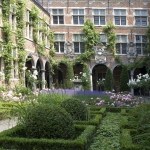 View photo gallery — The Museum came into existence following the acquisition by the Belgian State and the City of Antwerp of the house and workshops of the Plantin-Moretus printing firm which had been founded by Christopher Plantin (1514/1520-1588), one of the leading European printers of the sixteenth century. In the hands of successive generations of the Plantin-Moretus family, it had continued to play a major role in the commercial and political life of the city of Antwerp until the middle of the eighteenth century when the Spanish authorities withdrew the privileges which had up until then allowed them to exercise a virtual monopoly over the Spanish market. The firm never recovered from the loss of its Spanish market and from this time on printing would play a minor role in the diverse commercial activities of the Plantin-Moretus family. Fortunately for the Moretuses, they possessed a considerable fortune made in activities other than printing and, conscious of the importance of the heritage of Christopher Plantin and the prestige which it conferred upon the family, they maintained a modest commercial printing and publishing activity, but without making any real effort to keep up with the major technical changes brought by the Industrial Revolution . As a result, the firm found itself increasingly marginalised in the nineteenth century and, in the mid-1860s, it ceased its publishing activities altogether. The lack of initiative on the part of the Plantin-Moretus family since the middle of the eighteenth century was allowed the firm’s archives to remain intact. Thanks to the family’s commercial inertia, the Plantin-Moretus Museum possessed one of the richest typographical collections in the world which included not only the firm’s punches and matrices, woodcuts, engraved copper plates and printing presses, but also the books and prints which had been produced over the centuries and the archives necessary to understand the economic, intellectual and artistic history of the collection.
View photo gallery — The Museum came into existence following the acquisition by the Belgian State and the City of Antwerp of the house and workshops of the Plantin-Moretus printing firm which had been founded by Christopher Plantin (1514/1520-1588), one of the leading European printers of the sixteenth century. In the hands of successive generations of the Plantin-Moretus family, it had continued to play a major role in the commercial and political life of the city of Antwerp until the middle of the eighteenth century when the Spanish authorities withdrew the privileges which had up until then allowed them to exercise a virtual monopoly over the Spanish market. The firm never recovered from the loss of its Spanish market and from this time on printing would play a minor role in the diverse commercial activities of the Plantin-Moretus family. Fortunately for the Moretuses, they possessed a considerable fortune made in activities other than printing and, conscious of the importance of the heritage of Christopher Plantin and the prestige which it conferred upon the family, they maintained a modest commercial printing and publishing activity, but without making any real effort to keep up with the major technical changes brought by the Industrial Revolution . As a result, the firm found itself increasingly marginalised in the nineteenth century and, in the mid-1860s, it ceased its publishing activities altogether. The lack of initiative on the part of the Plantin-Moretus family since the middle of the eighteenth century was allowed the firm’s archives to remain intact. Thanks to the family’s commercial inertia, the Plantin-Moretus Museum possessed one of the richest typographical collections in the world which included not only the firm’s punches and matrices, woodcuts, engraved copper plates and printing presses, but also the books and prints which had been produced over the centuries and the archives necessary to understand the economic, intellectual and artistic history of the collection.
1884
Deutsches Buch- und Schriftmuseum (German museum of books and writing), Leipzig, Germany)
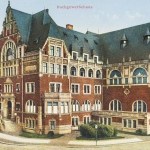 Originally the Deutsches Buchgewerbemuseum (German book trade museum), it changed name in 1950 when it was integrated with the Deutsche bücherei (German national library). The Deutsche Nationalbibliothek gives the foundation date as 1886. The origin of the museum was a report commissioned by several associations representing the German printing and publishing trades. This led to the creation of a joint association covering the entire book trade (the Centralverein für das gesamte Buchgewerbe) with the aim of setting up a museum. The first exhibition organised by the projected museum opened on the 12 July 1885 in the great hall of the Buchhändlerbörse, an imposing neo-classical building which had been built in the Ritterstrasse in 1834. It displayed manuscripts, old prints and early lithographs on loan from three private collections as well as from among the future museum’s own recent acquisitions. An exceptional collection of incunabula and prints was purchased for the Deutsches Buchgewerbemuseum a year later. The Museum was finally installed on a permanent basis three years later, in 1888, in the then premises of the Deutschen Buchhändlerhaus in Hospitalstrasse in the heart of the city’s printing and publishing district. In the Deutsches Buchgewerbemuseum the book shared the limelight with its means of production: the printing trade itself. As such it was among the earliest examples of what would become a long line of museums with a direct link with the printing trade, an industrial sector which has always been proud of its traditions and of the essential role which it has played in the development of Western society: a pride reinforced by Germany having been the birthplace of typography.
Originally the Deutsches Buchgewerbemuseum (German book trade museum), it changed name in 1950 when it was integrated with the Deutsche bücherei (German national library). The Deutsche Nationalbibliothek gives the foundation date as 1886. The origin of the museum was a report commissioned by several associations representing the German printing and publishing trades. This led to the creation of a joint association covering the entire book trade (the Centralverein für das gesamte Buchgewerbe) with the aim of setting up a museum. The first exhibition organised by the projected museum opened on the 12 July 1885 in the great hall of the Buchhändlerbörse, an imposing neo-classical building which had been built in the Ritterstrasse in 1834. It displayed manuscripts, old prints and early lithographs on loan from three private collections as well as from among the future museum’s own recent acquisitions. An exceptional collection of incunabula and prints was purchased for the Deutsches Buchgewerbemuseum a year later. The Museum was finally installed on a permanent basis three years later, in 1888, in the then premises of the Deutschen Buchhändlerhaus in Hospitalstrasse in the heart of the city’s printing and publishing district. In the Deutsches Buchgewerbemuseum the book shared the limelight with its means of production: the printing trade itself. As such it was among the earliest examples of what would become a long line of museums with a direct link with the printing trade, an industrial sector which has always been proud of its traditions and of the essential role which it has played in the development of Western society: a pride reinforced by Germany having been the birthplace of typography.
The Grolier Club (New York, United States)
The oldest existing bibliophile society in North America. Its program of public exhibitions ‘treats books and prints as objects worthy of display, on a par with painting and sculpture. It also maintains a research library specializing in books, bibliography and bibliophily, the history of printing, binding, illustration and bookselling and with a collection of examples of fine printing.
1886
Graphic arts division of the United States National Museum (Washington, United states)
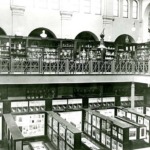 The United States National Museum opened in 1881 as the first purpose-built exhibition facility of the Smithsonian Institution with displays of anthropology, art, geology, history, and natural history. It did not initially include art collections. The graphic arts division was established in 1886 as part of the Museum’s mandate to also cover the field of ‘arts and industries’ (the original Museum building was later renamed Arts and Industries). Its first curator was Sylvester R. Koehler who had worked in Boston with the celebrated lithographic printer Louis Prang. Koehler established a permanent exhibition which emphasized art as industry, showing its technological development rather than focusing on aesthetics. His reasoning was that while other curators wanted ‘a collection of fine showpieces to dazzle the public eye and satisfy the wants of the fastidious private collector’, he wanted a collection he could use ‘to teach people’. The dosplay covered a wide range of graphic processes and media from the origination of artwork through to industrial process engraving. When Koehler died in 1900 the management of the collection was transferred to the department of anthropology of the Smithsonian Library.
The United States National Museum opened in 1881 as the first purpose-built exhibition facility of the Smithsonian Institution with displays of anthropology, art, geology, history, and natural history. It did not initially include art collections. The graphic arts division was established in 1886 as part of the Museum’s mandate to also cover the field of ‘arts and industries’ (the original Museum building was later renamed Arts and Industries). Its first curator was Sylvester R. Koehler who had worked in Boston with the celebrated lithographic printer Louis Prang. Koehler established a permanent exhibition which emphasized art as industry, showing its technological development rather than focusing on aesthetics. His reasoning was that while other curators wanted ‘a collection of fine showpieces to dazzle the public eye and satisfy the wants of the fastidious private collector’, he wanted a collection he could use ‘to teach people’. The dosplay covered a wide range of graphic processes and media from the origination of artwork through to industrial process engraving. When Koehler died in 1900 the management of the collection was transferred to the department of anthropology of the Smithsonian Library.
1888
Musée des arts décoratifs (Paris, France)
1890 circa.
South Kensington Museum paper-making and printing section (London, United Kingdom)
The South Kensington Museum was created in 1857 on the basis of the collections of the Royal Society of Arts and items displayed at the Great Exhibition of 1851. As of the 1890s (or perhaps before), it offered a display of printing machinery. The South Kensington Museum was principally a museum of industrial and decorative arts, but it also possessed various scientific and technical collections. In 1909 the industrial and decorative arts collections gave birth to the Victoria and Albert Museum and the same year the scientific and technical collection were administratively separated as the ‘Science Museum’.
1895
St Bride printing library (London, United Kingdom)
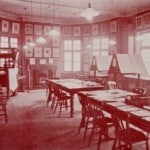 Set up as a library it later opened a museum space.
Set up as a library it later opened a museum space.
1897
Musée Jenisch (Vevey, Switzerland)
Founded as a fine arts museum it became home to the print collections of Oskar Kokoschka and the Canton of Vaud in 1989
1900
Gutenberg museum (Mainz, Germany)
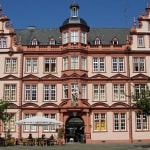 The most emblematic of the earliest printing museums is the Gutenberg Museum, established in 1900 in Mainz, the birthplace of Johannes Gutenberg. Like the Plantin-Moretus Museum it was intended to enhance the prestige of the city by celebrating one of its most famous sons. The Antwerp museum celebrated one of Europe’s foremost printers of the sixteenth century. The Gutenberg Museum went one step further in celebrating one of the most important inventors and inventions of all time. And in celebrating one of the founding events of the modern world, it brought glory not only upon the city of Mainz, but upon the entire German nation. As such it contributed to the construction of the history and identity of what was, in a sense, still a young country, the unification of the German Empire dating from 1871.
The most emblematic of the earliest printing museums is the Gutenberg Museum, established in 1900 in Mainz, the birthplace of Johannes Gutenberg. Like the Plantin-Moretus Museum it was intended to enhance the prestige of the city by celebrating one of its most famous sons. The Antwerp museum celebrated one of Europe’s foremost printers of the sixteenth century. The Gutenberg Museum went one step further in celebrating one of the most important inventors and inventions of all time. And in celebrating one of the founding events of the modern world, it brought glory not only upon the city of Mainz, but upon the entire German nation. As such it contributed to the construction of the history and identity of what was, in a sense, still a young country, the unification of the German Empire dating from 1871.
The glorification of Gutenberg had been a long process. He had been mentioned as the inventor of typographical printing as early as the fifteenth century, but at that time his reputation was far from assured. In 1540, the centenary of his invention was celebrated in Wittemberg only. (The centenaries are traditionally celebrated in Germany on the fortieth year of each century.) The bicentenary and tercentenaries of the invention of printing celebrated in Leipzig in 1640 (with festschrifts published also in Cologne, Dresden, Breslau and Strasbourg) and 1740 spoke rather of Fust and Schöffer and their ‘assistant’ Gutenberg. It was only in the eighteenth century, in the face of numerous arguments and counter-arguments, that he began to be recognized as the inventor.
The origins of the Gutenberg Museum go back to 1831 when the Verein für Kunst und Literatur in Mainz (Association for Art and Literature in Mainz) initiated a project to commission a Gutenberg memorial. The headed notepaper of the Association included, along with the silhouette of the cathedral and various allegorical figures, the outline of a ‘Gutenberg temple’. The Gutenberg Museum as we know it today was established however by a group of Mainz citizens under the auspices of the local municipal library. The origin of the project was a commemorative international exhibition to celebrate the 500th anniversary of the supposed birth of Johannes Gutenberg, the exact date of his birth being unknown. The organizing committee of the event laid out the exhibition in three parts: a historical section showing printing equipment and printed products from all periods; a second section providing a panorama of contemporary graphic arts; and a final section dedicated to the latest developments in printing technology. After the exhibition the new Gutenberg Museum―whose creation was the ultimate objective of the organisers―was installed in part of the Kurfürstliches Schloß (Electoral Palace) which already housed the city’s library. The two institutions would move together into new premises on the Rheinallee in 1912 and later, in 1927, the museum would move to its current location in one of Mainz’s most impressive buildings, the Zum Römischen Kaiser built in 1664.
The new Museum received numerous donations from German publishers, printers and manufacturers of printing equipment, the idea being that it should be able to offer visitors an overview of five centuries of printing. In reality, however, the permanent exhibition was largely dominated by the printed book. Although the Museum was dedicated to the memory and the glory of Gutenberg and the invention of letterpress printing, technical artefacts played a relatively small part in its permanent displays in the first decades of its existence during which a considerable effort was made to use the existing exhibition space to best effect. It was only in 1925 that the Museum began to acquire new spaces and the techniques of type founding and letterpress printing began to acquire greater visibility with the installation of a ‘reconstruction’ of Gutenberg’s workshop including a facsimile printing press inspired by the earliest known illustrations of printers’ workshops. Nothing was of course known about what Gutenberg’s workshop might have looked like or contained, so the construction of the facsimile was largely a matter of conjecture. The purpose of the workshop was to allow visitors to familiarize themselves with the traditional techniques and objects of type founding and letterpress printing which were fast disappearing as a result of the mechanisation and industrialisation of the printing industry. A year later, in 1926, the Museum began publication of the Gutenberg Jahrbuch which quickly became the leading forum for scholarly debate on all aspects of Gutenberg’s invention and printed works, and of early printing in general.
During this period the Museum was also increasingly present at major international industrial and other exhibitions.
In an article published in the French printing trade journal Le Bulletin official Bulletin officiel de l’Union syndical des Maîtres imprimeurs in 1930, the curator of the Museum, Aloys Ruppel, emphasised the international aspect of the it’s programme as it had been conceived from the very beginning, ‘to gather, study, exhibit and publish everything related to the history of printing in all the civilized nations of the world. […] With this programme the Gutenberg Museum considers itself to be, or to be in the process of becoming, the universal museum of printing.’ After reminding readers of the achievements of Gutenberg and the City of Mainz, Rupel continued: ‘The Museum should become the Temple to the glory of the City of Mainz for its greatest son, the central international depository of all the products of printing and for printers’ machines and tools; the scientific centre for the study of printing history worldwide; a place where all the disciples of the grand master can draw inspiration for their work.’ Ruppel considered that the Museum had already made considerable progress in the first three decades of its existence and hoped that it would not only be supported by printers across the world, but that their professional organisations would even go so far as to include the development of ‘their museum in Mainz’ as one of their principle missions as enshrined in their statutes. In which case the ‘civilised nations of the world and their governments’ would not hesitate to back the Gutenberg Museum and offer exhibits of everything relating to the history of printing in their country. To advance the Museum’s cause, the 1925 jubilee edition of the Gutenberg Jahrbuch had already been given personally to all heads of state by Germany’s ambassadors and foreign envoys and the editions of 1926 and 1929 had been ‘given to the governments of civilised nations by their ambassadors and envoyés in Berlin’.
The Mainz Gutenberg Museum was, and remains, the foremost printing museum in Europe and can justifiably lay claim to a truly worldwide reputation because of the importance of the historical personality and the invention which it celebrates, and because of the importance of its collections which include two original Gutenberg bibles.
The Museum is also remarkable for the extent of its permanent display which, unlike most of its counterparts in other countries which tend to be relatively modest affairs, can be compared to that of a moderate-sized fine art or natural history museum.
Gutenberg museum (Bern, Switzerland)
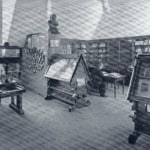 The Gutenberg museum in Berne, Switzerland, opened the same year as its homologue in Mainz. It was not, however, on the same scale and was originally created as the ‘Chambre Gutenberg’ in the City’s local history museum. In 1910 an association of friends of the Gutenberg Museum (Förderverein Schweizerisches Gutenbergmuseum) was established. The installation was expanded in 1922 to several rooms after a year’s closure for renovation work. The Museum remained under the auspices of the City of Berne until 1985. In 1991 it was decided to move the Museum to Fribourg where it reopened in the year 2000 as the Musée Suisse de l’industrie graphique et de la communication. In April 2022, its owner at the time, the Association patronale de l’industrie suisse des arts graphiques (Viscom), decided to close the museum and sell the premises to the city of Fribourg. A new incarnation of the museum has been announced as part of the Museum ENTER in Solothurn, Switzerland, from 2024.
The Gutenberg museum in Berne, Switzerland, opened the same year as its homologue in Mainz. It was not, however, on the same scale and was originally created as the ‘Chambre Gutenberg’ in the City’s local history museum. In 1910 an association of friends of the Gutenberg Museum (Förderverein Schweizerisches Gutenbergmuseum) was established. The installation was expanded in 1922 to several rooms after a year’s closure for renovation work. The Museum remained under the auspices of the City of Berne until 1985. In 1991 it was decided to move the Museum to Fribourg where it reopened in the year 2000 as the Musée Suisse de l’industrie graphique et de la communication. In April 2022, its owner at the time, the Association patronale de l’industrie suisse des arts graphiques (Viscom), decided to close the museum and sell the premises to the city of Fribourg. A new incarnation of the museum has been announced as part of the Museum ENTER in Solothurn, Switzerland, from 2024.
1902
Het Persmuseum (Amsterdam, Netherlands)
Het Persmuseum in Amsterdam was originally based on the personal collection of newspapers and magazines of a Dutch journalist, D.A. van Waalwijk, who had considerably enlarged his collection in 1902 with acquisition of a large number of titles at an auction sale. Established as an archive the same year the collection was baptised the Nederlandsche Pers-museum (Dutch Press Museum) in 1903 though it is not clear in modern accounts of the origins of the museum when it actually began to display its collections publicly. In 1925 the Persmuseum moved to the Typographic Museum, also in Amsterdam, and after a closure for the duration of the Second World War moved again several times before being accommodated in 2001 by the Internationaal Instituut voor Sociale Geschiedenis (International Institute for Social History). It closed its doors to the public on 19 June 2017, at which point its collections were transferred to Sound and Vision, the institute for media culture in Hilversum which plans to open a new media museum in 2022.
1904
Museum Enschedé (Haarlem, Netherlands)
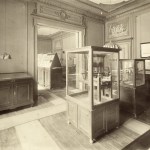 The Museun Eschedé was formally established in 1904 as the Enschedé Museum Foundation whose purpose was to preserve all materials pertaining to the history of the Enschedé firm and ‘to store and collect antiques, valuables and relevant curios’. The origins of the firm go back to 1703, and by the end of the nineteenth century the firm’s archives―which included those of several historically important type foundries which it had acquired over the years―were disorganised, being dispersed in various different locations. A focus was given to the history of the firm by a ‘museum room’ which could be visited by appointment and which had existed within the firm since at least 1897. The company’s records are vague however as to when the Museum room actually opened. It’s first official recognition by the company came in 1904 when the Enschedé Museum Foundation was set up with the object of preserving as much as possible concerning the history of the firm, the Enschedé family, including paintings and other related objects of historical interest. According to contemporary press reports it was formally inaugurated probably sometime around the beginning of 1913 and was largely the result of the efforts of Charles Enschedé (1855-1919) who perhaps already had in mind the idea of setting up a museum when he published his monumental history of the firm in 1893. A catalogue of the Museum’s collection was published in 1916.
The Museun Eschedé was formally established in 1904 as the Enschedé Museum Foundation whose purpose was to preserve all materials pertaining to the history of the Enschedé firm and ‘to store and collect antiques, valuables and relevant curios’. The origins of the firm go back to 1703, and by the end of the nineteenth century the firm’s archives―which included those of several historically important type foundries which it had acquired over the years―were disorganised, being dispersed in various different locations. A focus was given to the history of the firm by a ‘museum room’ which could be visited by appointment and which had existed within the firm since at least 1897. The company’s records are vague however as to when the Museum room actually opened. It’s first official recognition by the company came in 1904 when the Enschedé Museum Foundation was set up with the object of preserving as much as possible concerning the history of the firm, the Enschedé family, including paintings and other related objects of historical interest. According to contemporary press reports it was formally inaugurated probably sometime around the beginning of 1913 and was largely the result of the efforts of Charles Enschedé (1855-1919) who perhaps already had in mind the idea of setting up a museum when he published his monumental history of the firm in 1893. A catalogue of the Museum’s collection was published in 1916.
Despite the very considerable volume of documentation which has been preserved, little is known at present about how the Museum was run up until the Second World War. Various mentions are to be found in the reports of the firm’s board meetings of complaints about lack of space to store the archives and personnel to adequately catalogue them.
From the outset, the Museum Enschedé displayed numerous technical artefacts illustrating the development of printing over a long period. Though the collections were dominated by the Enschedé firm and its activities, the permanent exhibition also offered a broad perspective on the development of printing and the art of typography generally over the two centuries during which the company had been in existence and had closely followed technical developments. In particular, the importance of the firm and of the various other companies which it had acquired gave it a unique opportunity to give a fully illustrated overview of the history of typography in the Netherlands. In contrast to the Plantin-Moretus Museum in Antwerp, whose historic presses had come from a firm which had been largely by-passed by technological and industrial progress in the nineteenth century, the Museum Enschedé was created by an enterprise which was not only the repository of an extremely rich collection of historical material but was also an important and thriving industrial printing firm active in some of the most technically demanding sectors of the printing industry (banknote printing in particular), and whose commercial dynamism complemented its pride in its prestigious history.
In 1990 Joh. Enschedé moved to the Oudeweg. However, as part of a printing firm that printed banknotes and stamps and all sorts of security printing the Museum could not operate as a public facility. In the mid 1990s a major cataloguing campaign was undertaken under the direction of Johan de Zoete who documented some 90,000-odd items (archives, banknotes, stamps, typefounding materials, etc.) and continued to receive a considerable number of researchers.
In 2014 the firm was taken over by a German investment company at which point the museum ceased to function as an autonomous unit within the firm. It was then agreed to transfer the entire collection to the North Holland Archives, where they still can be consulted by appointment. What printing equipment had survived over the years is now also also held by the North Holland Archives.
1906
Musée du livre (Brussels, Belgium)
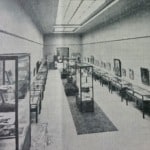 The idea of setting up a Musée du livre in Brussels was raised in 1904 by Jean Van Overstraeten and Edmond Gregoir, two key members of the Cercle des études typographiques, a professional organisation that was part of the general movement of renewal of typographical standards which was taking place in Europe at the time. The suggestion that was enthusiastically adopted their colleagues. An appeal for support was launched and succeeded in collecting enough signatures to convince the Belgian Minister of industry to commission a report on the proposition, to be prepared by Gregoir and van Overstraeten. It also attracted the active collaboration of the secretary of the Cercle belge de la librairie, Ernest Vandeveld who would remain on the board of the Musée until his death in 1934.
The idea of setting up a Musée du livre in Brussels was raised in 1904 by Jean Van Overstraeten and Edmond Gregoir, two key members of the Cercle des études typographiques, a professional organisation that was part of the general movement of renewal of typographical standards which was taking place in Europe at the time. The suggestion that was enthusiastically adopted their colleagues. An appeal for support was launched and succeeded in collecting enough signatures to convince the Belgian Minister of industry to commission a report on the proposition, to be prepared by Gregoir and van Overstraeten. It also attracted the active collaboration of the secretary of the Cercle belge de la librairie, Ernest Vandeveld who would remain on the board of the Musée until his death in 1934.
The first fruit of this initiative was the creation in Brussels of a Maison du livre, an umbrella organisation whose purpose was to federate a wide range of groups and activities related to the printing and book trades, and which was presided over and managed by Paul Otlet. The Cercle was certainly influenced by the enthusiastic report that Gregoir and van Overstraeten had made after a visit to the German precursor of their project, the Deutschen Buchhändlerhaus in Leipzig to gather information about its aims, its operation and budget. It should be remembered that the use of the word ‘livre’ in the name of the Maison du livre needs to be qualified for it is not always easy to translate into English. For it has multiple connotations. Most commonly it is used to mean ‘book’, but it is very often also used, as in this case, to refer to the book, newspaper and printing trades in general.
By the time it was inaugurated, the Maison du livre had gained the support of nineteen associations and groups involved in the book trades, including trade unions, employers organisations and societies of bibliophiles, and with the help of a wide range of collaborators began a programme of talks, courses and exhibitions aimed at promoting progress in printing, illustration, bookbinding, bookselling and the books arts in general as well as raising public consciousness about the history of printing and books. The facilities of the Maison du livre included a library, a gallery for temporary exhibitions and a photographic workshop. And it also produced a quarterly publication composed of plates reproducing the ‘chef d’oeuvres’ of Belgian graphic arts one of whose aims was to keep the country’s printers up to date with the latest technical innovations.
Then, in 1905, the Cercle des études typographiques announced its intention to celebrate its tenth anniversary the following year with an international exhibition of image reproduction processes for book production whose organising committee had been formed under the patronage of no lesser a figure than the Minister of industry and labour and with the Mayor of Brussels as honorary president. The subject of the exhibition was adventurous to say the least for what was to be the Cercle’s most important exhibition to date. New image reproduction processes were of course a major preoccupation for printers, but it was far from evident that an exhibition on the subject would attract the attention of the general public.
The Cercle des études typographiques’ efforts during its first ten years of activity were crowned with success with the opening in 1906 of the Musée du livre which was housed in the Maison du livre a year later. In 1911 it became part of the Mundaneum where it remained until 1929. It was then transferred to the premises of the Palais des Beaux-Arts in Brussels until its closure in the 1950s.
(The above photograph is of an Musée du livre exhibition in 1936 of French-language books translated from the Flemish.)
Musée international de la presse (Mons, Belgium)
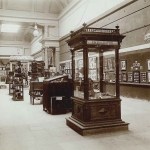 The Musée international de la presse resulted from the conjunction of two quite different milieux, each with its own distinct approach to print media: on the one hand the printing trade and on the other the emergent disciplines of library sciences and documentation. A conjunction that was driven by several organisations which at first sight might seem quite disparate – the Cercle des collectionneurs de journaux, the Cercle des études typographiques, the Union de la presse périodique and the Office international de bibliographie. The synergy which developed among these various actors resulted in the creation of three closely related structures: the Maison du livre, the Musée du livre and the Musée international de la presse. The full story of the collaborations and development of these three organisations is complicated by the fact that their activities often overlapped, that they occupied the same premises as the multifaceted Office international de bibliographie, and that they also shared some key administrators over a period of a quarter century.
The Musée international de la presse resulted from the conjunction of two quite different milieux, each with its own distinct approach to print media: on the one hand the printing trade and on the other the emergent disciplines of library sciences and documentation. A conjunction that was driven by several organisations which at first sight might seem quite disparate – the Cercle des collectionneurs de journaux, the Cercle des études typographiques, the Union de la presse périodique and the Office international de bibliographie. The synergy which developed among these various actors resulted in the creation of three closely related structures: the Maison du livre, the Musée du livre and the Musée international de la presse. The full story of the collaborations and development of these three organisations is complicated by the fact that their activities often overlapped, that they occupied the same premises as the multifaceted Office international de bibliographie, and that they also shared some key administrators over a period of a quarter century.
Created following a congress of the periodical press, the Musée international de la presse was integrated into the collections of the Institut international de bibliographie and managed in collaboration with the Cercle des collectionneurs de journaux and the Union de la presse périodique. The aim was to collect at least the first and last issue of every periodical published in the world. It is now part of the Mundaneum archive and exhibition centre in Mons (Belgium).
1910
Národní technické museum (National Technical Museum, Prague, Czechoslovakia)
Like many other technical and industrial museums, the Czech National Technical Museum included a section devoted to printing and papermaking from the time it first opened its doors to the public in 1910. In fact, the origins of the National Technical Museum and its printing collections go back well beyond the turn of the twentieth century and can be traced to 1862 when Adalbert Fingerhut (better known as Vojtĕch Náprstek) formed a committee to create a Bohemian museum of industry which began collecting technical artefacts related to Czech industrial production from all over Europe. Náprstek was a partisan of the nationalist cause, a freethinker and, later advocate of women’s suffrage and had lived in the United States for ten years after fleeing from his home country in 1848 to avoid the displeasure of the Habsburg authorities. This experience would appear to have encouraged his interest in all forms of technical progress which he would later advocate as a city councillor in Prague as well as in his activities as a collector and as an organiser of exhibitions. One of his more innovative exhibitions in the 1860s was of household appliances including sewing machines which were virtually unknown in his country at that time―as was the idea that industrial design could be of interest to the general public.
As Náprstek’s project to establish an industrial museum advanced, printers responded enthusiastically and he was able to build a printing collection with the support of the Prague Book Printers’ Association (Spolek fakrorů pražských knihtiskáren), the Prague society of lithographers, and the directors and staff of various printing houses. Then, in 1885, the decision was taken with the backing of several influential Czech printers to build an exhibition dedicated specifically to printing. The exhibition was installed in a building which had been newly constructed for Náprstek’s Czech Industrial Museum in the court of the U Halánků building and continued to grow over the years to cover historical and contemporary industrial aspects of printing, exhibiting both machines and examples of printed documents. The exhibition benefited from an important retrospective exhibition (Retrospektivnívýstava) that was organised in 1891 by the Prague Association of Printers and Compositors, strongly supported by local printers, for many of the objects on display were subsequently transferred to Náprstek’s museum, on deposit from the printing firms which had lent them for the temporary exhibition.
When Náprstek died in 1894 the leadership of the future national technical museum’s printing group passed to Dr Jaroslav Husník, the son of Jakob Husník one of the pioneers of collotype printing who was himself commercially involved in industrial three-colour letterpress printing. It was under the aegis of Dr Husnik that the printing department of the Museum was rebuilt and expanded in 1903 with new exhibits coming from the trade to further illustrate the current state of the graphic arts.
Then, in 1908 with the support of professors from the Czech Technical University and the Prague chamber of commerce Náprstek’s visionary project for a technical museum finally gave birth to an institution which opened to the public two years later as the Museum, Conservatory of Arts and Crafts. Printing presses which had been collected by Náprstek’s group were on display from the moment the Museum opened in 1910 and, a year later, printing was given a new dedicated display space of its own under the title Polygrafie. By 1919 a graphic arts section had been formally constituted within the Prague Technical Museum’s collections. It is interesting to note that the supporters of the project were influenced by the technical museums which had recently been founded in Munich and Vienna, as well as by the important industrial exhibition which had been held in Prague in 1891. To begin with the Museum was privately financed and it was only in 1918, when it became the Czechoslovakian Technical Museum, that it was partly subsidised by the recently formed Czech Republic.
Behind the development of the graphic arts section of the National Technical Museum was the institution’s preoccupation with the promotion of Czech science, technology and industrial innovation which informed its acquisition and exhibition policies, examples of current Czech industrial production coming principally in the form of gifts from industrialists who were represented in the Technical Museum’s association. The one exception that was made to this general rule was the collection of printing presses that were exhibited in the early years of the Museum and which were for a long time of foreign manufacture because there were virtually no Czech firms in this field until much later in the twentieth century.
Initially historical and contemporary techniques were represented side by side in the Museum, an approach which was common in industrial exhibitions, but which later went out of fashion only to reappear in museums in recent times. Another particularity of the Museum’s printing collection during this formative period was that it was exhibited in its totality. Or as today’s Catalogue of the printing collections puts it ‘The exhibition was identical to the collection’.
The Czech National Technical Museum was one of many printing sections set up within the new museums of science and technology which sprang up at the turn of the twentieth century. As such it benefitted from a favourable combination of circumstances: the desire to develop a more permanent tool for the promotion of national industry which had been so well served by international expositions in the second half of the nineteenth century; the need to encourage interest and spread knowledge about science and technology which had become the mainstays of nearly all forms of industrial and economic activity; and the instrumentalization of great inventors and their inventions in the cause of international prestige. Printing was at its apogee both as an industrial process and as the world’s first mass media. In addition, the very foundations of the forms and uses of print in society were being profoundly altered by the advent of industrial capitalism aided and abetted by electrification, photomechanical processes and new communication techniques. What could be better than printing as an example of technological change and its impact on society and culture?
1911
Museum het Rembrandthuis (Rembrandt house museum, Amsterdam, Netherlands)
The house in which the artist lived from 1639 to 1656 was bought by the City of Amsterdam and set up as a foundation on the occasion of the 300th anniversary of Rembrandt in 1906. Dedicated principally the artist’s graphic work, the collection grew rapidly in the first half of the century and currently includes 260 of the 290 known etchings by Rembrandt.
1917
John M. Wing Foundation on the History of Printing (Newberry Library, Chicago, United States)
Although neither a museum, nor European, the Wing collection merits mention as a landmark resource in the history of typography. Continually enriched since the original bequest, is it one the World’s leading collections in the field.
1920
Smithsonian graphic arts department (temporary exhibitions programme)
In 1920 Ruel Tolman, a practising artist and etcher was appointed assistant curator as part of a reorganisation that transferred the Smithsonian Institution’s graphic arts collections to the department of arts and industries. Under his direction they took on new life with an ambitious programme of temporary exhibitions.
1923
Musée Toulouse-Lautrec (Albi, France)
A significant early creation of a museum with a focus on lithography and poster art, it was formally incorporated following the gift made the year previously by the family of the artist to the town of Albi in the South-West of France, Henri de Toulouse-Lautrec’s birth place. The donation of over a thousand works by the artist included paintings, lithographs, drawings and a very extensive collection of his illustrated posters.
1924
Musée Lorilleux (Puteaux, France)
A notable creation of the inter-war period in France was that of the Musée Lorilleux, a company museum set up in 1924 by the successful ink manufacturer of the same name. The Lorilleux firm was founded in 1818 by Pierre Lorilleux, who was at the time employed by the Imprimerie royale, with the aim of manufacturing inks to be sold ready prepared to printers who had up until then prepared their own. In the second half of the century the firm became highly successful as the full impact of the Industrial Revolution came to be felt in printing and as new printing processes, steam presses and paper qualities required a rapidly expanding range of inks. In 1870 Pierre Lorilleux’s son Charles, who had joined the firm in 1843, undertook a massive expansion of the factory which had originally begun on a modest scale at Puteaux in the west of Paris, or to be more precise, in a hamlet known as the Moulin de Chante-Coq which took its name from an ancient windmill which was now on the site of the firm’s eighteen hectares site. The Moulin was adopted as the firm’s trademark and would later be occupied by the Musée.
Lorilleux was for many years France’s leading ink manufacturer with important foreign markets thanks to its ability to keep pace with the major technical innovations which were at that time transforming printing processes, papermaking and colour printing of all varieties. The firm was also very good at developing partnerships with the most innovative printers, such as the major Chaix firm which at one point, as part of a commercial agreement with Lorilleux, include the mention ‘Encre Lorilleux’ following its own name on everything it printed. It was also very active in its publicity campaigns, producing a host of objects bearing its brand image and being among the first to use the services of Alphonse Mucha who was at that time, 1893, only beginning to develop the graphic style which would make his posters universally known to the general public.
When the Lorilleux Museum opened in 1924 it was probably open principally for customers of the firm rather than to the general public. Indeed, some years later, in his Enclcylopédie des arts graphiques, René Billoux refers to it as a ‘petit musée professionnel’. At any rate it seems to have had a modest existence as there seems to be virtually no mention of it in the French trade press before 1934, when it was the subject of a three-page advertising insert that appeared in Bulletin official the official organ of the printing employers’ association, the Union syndicat patronal & fédération des syndicats des maîtres imprimeurs de France. By that time the Musée was open to the public for the insert discretely stated that ‘La famille Lorilleux a pieusement conservé Chante-Coq. […] Un musée y a été établi où, au milieu d’estampes anciennes, d’impressions rares de toutes époques, de multiples et précieux documents, l’imprimeur peut vivre toute l’histoire de son art, et aussi la progression continue de l’industrie des encres d’imprimerie qui, aujourd’hui, s’est assurée une des premières places au rang de celles qui font le plus honneur à l’activité française.’
It is slightly curious that over the previous ten years there had been no mention of the Musée in the columns of the Bulletin official, one of the principal trade journals of the time, for the Lorilleux firm was one of its main advertisers, occupying systematically the back cover with a full-page advertisement and not uncommonly with an insert at the beginning of the advertising section showcasing its latest inks, often in spectacular fashion. Lorilleux and the employers’ organisation also occupied offices on opposite sides of the rue Sugar in Paris, the former at number 16, le latter at number 7. And in 1922 the Bulletin official had organised a small exhibition in its offices which included correspondence between Alois Senefelder, his wife and brother as well as some of Senefelder’s monochrome and colour printing and examples of his attempts to find an alternative printing substrate to stone. Other objects on show included the first photographs taken by Ducos du Hauron, who had carried out important experiments in colour printing in the nineteenth century.) All of these documents were at the time in the possession of the editor of the Bulletin official, René Billoux who donated them shortly afterwards the Musée Lorilleux.
The Musée Lorilleux remained in existence until at least 1972 when the trade magazine Caractère published a feature article on the history of the Lorilleux firm. It was permanently closed sometime around 1974 and the building was given to the municipality of Puteaux in 1979 on the closure of the factory, when part of its collection – including the historical material from Alois Senefelder concerning the process he had patented for printing lithographically from ‘paper’ plates – was given to Lyon City Library who in turn gave a certain number of documents and a painting entitled Le lithographe (which can be seen in one of the accompanying illustration) to the Musée de l’imprimerie et de la communication graphique (which also belongs to the City of Lyon).
(Photographs courtesy of Caroline Aubry.)
Подполъная типография ЦК РСДРП, 1905-1906 гг. (Clandestine Printing House of the Central Committee of the Russian Social Democratic Labour Party, i.e. Bolsheviks), Moscow, Russian Soviet Federative Socialist Republic)
Museum still operating (2020). (Source: Mуэеи книги directory.)
Museum of Ukrainian Writing and Printing (Ukraine)
Precursor to the present Museum of the Book and Printing of Ukraine, it was closed by the Soviet authorities in 1934.
1925
Biblioteca Estense (permanent book exhibition, Modena, Italy)
In 1925, the library of Modena established a permanent book exhibition on the occasion of the return of the Este Bible to its collections. Though the exhibition concentrated on the artistic aspects of the book – illuminated manuscripts, illustrated printed books, bookbinding – the exhibition included a section on early printing in the Duchy of Modena. The exhibition still exists today but has lost much of its permanent aspect. For conservation reasons an increased accent has been placed on the rotation of the exhibits as a means of bringing the attention of the general public to the highlights of the Library’s collections. (Andrea de Pasquale, ‘Des musées dans les bibliothèques : le cas des bibliothèques d’Etat en Italie, XIXe – XXe siècle’, Histoire et civilisation du livre, vol. X, p. 239-253, Genève, 2014.)
The Library, now a Biblioteca Nazionale, moved to its location at the Palazzo dei Musei in 1882 and became part of the new Gallerie Estensi Museum in 2016.
1929
Biblioteca Nationale Marciana (permanent book exhibition, Venice, Italy)
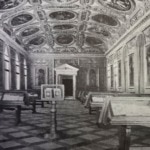 In 1905 the Biblioteca Nazionale Marciana in Venice moved into new premises and took the occasion to admit readers to the new manuscript reading room where they could inspect two large display cabinets containing some of the most outstanding items from the Library’s collections. It would be another twenty-five years, however, before the Library would open a permanent exhibition space, on the occasion of the first Congrès mondial des bibliothèques et de bibliographie. The director of the Library, Luigi Ferrari, who had also been in charge of the organisation of the Congress, opposed the 1938 decision which had been taken at national level to close all permanent book exhibitions in libraries and managed to keep that of the Marciana open. The library closed its permanent exhibition space in 1974 for conservation reasons. (Andrea de Pasquale, ‘Des musées dans les bibliothèques : le cas des bibliothèques d’Etat en Italie, XIXe – XXe siècle’, Histoire et civilisation du livre, vol. X, p. 239-253, Genève, 2014.)
In 1905 the Biblioteca Nazionale Marciana in Venice moved into new premises and took the occasion to admit readers to the new manuscript reading room where they could inspect two large display cabinets containing some of the most outstanding items from the Library’s collections. It would be another twenty-five years, however, before the Library would open a permanent exhibition space, on the occasion of the first Congrès mondial des bibliothèques et de bibliographie. The director of the Library, Luigi Ferrari, who had also been in charge of the organisation of the Congress, opposed the 1938 decision which had been taken at national level to close all permanent book exhibitions in libraries and managed to keep that of the Marciana open. The library closed its permanent exhibition space in 1974 for conservation reasons. (Andrea de Pasquale, ‘Des musées dans les bibliothèques : le cas des bibliothèques d’Etat en Italie, XIXe – XXe siècle’, Histoire et civilisation du livre, vol. X, p. 239-253, Genève, 2014.)
Biblioteca Braidense (permanent book exhibition, Milan, Italy)
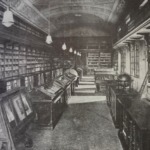 The 1929 Congrès mondial des bibliothèques et de bibliographie saw the opening of a second book exhibition in addition to that of the Biblioteca Nationale Marciana in Venice. In Milan the Biblioteca Braidense organised an exhibition which in due course became permanent. Installed in two large rooms, twenty-four display cabinets contained illuminated manuscripts and printed books, rare and illustrated books of the fifteenth and sixteenth centuries, decorated book bindings, books by Aldus Manutius and other rare and precious editions. According to the catalogue the exhibition contained many of the most prestigious items belonging to the library. The permanent exhibition only lasted for about ten years and by 1940 had been taken down in order to free the space for storage of new acquisitions. The space was again used to display books – this time in temporary exhibitions – as of the early 1950s. (Andrea de Pasquale, ‘Des musées dans les bibliothèques : le cas des bibliothèques d’Etat en Italie, XIXe – XXe siècle’, Histoire et civilisation du livre, vol. X, p. 239-253, Genève, 2014.)
The 1929 Congrès mondial des bibliothèques et de bibliographie saw the opening of a second book exhibition in addition to that of the Biblioteca Nationale Marciana in Venice. In Milan the Biblioteca Braidense organised an exhibition which in due course became permanent. Installed in two large rooms, twenty-four display cabinets contained illuminated manuscripts and printed books, rare and illustrated books of the fifteenth and sixteenth centuries, decorated book bindings, books by Aldus Manutius and other rare and precious editions. According to the catalogue the exhibition contained many of the most prestigious items belonging to the library. The permanent exhibition only lasted for about ten years and by 1940 had been taken down in order to free the space for storage of new acquisitions. The space was again used to display books – this time in temporary exhibitions – as of the early 1950s. (Andrea de Pasquale, ‘Des musées dans les bibliothèques : le cas des bibliothèques d’Etat en Italie, XIXe – XXe siècle’, Histoire et civilisation du livre, vol. X, p. 239-253, Genève, 2014.)
1930
Crane Museum of Papermaking (Dalton, Massachusetts, United States)
This company museum was set up in 1930 in Dalton, Massachusetts by the long-established Crane firm of papermakers. The origins of the Crane firm go back to the late eighteenth century and since the late nineteenth century one of its specialities has been the manufacture of banknote paper. The museum is of particular interest because it is among the oldest corporate museums in the United States. It was expanded in 2001 as part of the company’s bicentennial celebration, and again in 2014 to accommodate the firm’s archives and create an area for hands-on papermaking and paper arts.
1932
Museum of Modern Art / Moma (New York, United States)
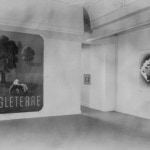 Echoing the charter of the Metropolitan Museum of Arts of 1870, that of the Museum of Modern Art, which was founded in New York in 1929, included ‘encouraging and developing the study of modern arts and the application of such arts to manufacture and practical life’. More precisely, the Moma was the first fine art museum to open a department of architecture and design, the starting point of what quickly became a highly-focused collection of graphic design. To this end it began to systematically collect and regularly exhibit examples of advertising art, ‘recognizing the enormous power of the art director in shaping and directing public taste through the far-reaching medium of advertising and editorial art’. Initially largely dominated by posters it enlarged its centres of interest to become one of the world’s leading graphic design collections.
Echoing the charter of the Metropolitan Museum of Arts of 1870, that of the Museum of Modern Art, which was founded in New York in 1929, included ‘encouraging and developing the study of modern arts and the application of such arts to manufacture and practical life’. More precisely, the Moma was the first fine art museum to open a department of architecture and design, the starting point of what quickly became a highly-focused collection of graphic design. To this end it began to systematically collect and regularly exhibit examples of advertising art, ‘recognizing the enormous power of the art director in shaping and directing public taste through the far-reaching medium of advertising and editorial art’. Initially largely dominated by posters it enlarged its centres of interest to become one of the world’s leading graphic design collections.
The starting point was the private collection that the Moma’s then director Alfred Barr and his associate director Jere Abbott had amassed while travelling in Europe and donated to the Museum. The collection was put together according to aesthetic rather than sociological or economic considerations. i.e. the poster as art (and by implication as a collectible item) took precedence over the poster as an advertising medium with the result that when exhibited the posters were largely divorced from the products they had been designed to advertise. (Photo : Moma.) During the 1930s and 1940s the Moma acquired a certain number of posters from earlier periods, mostly from World War I, as historical items, though they seldom featured in exhibitions.
Posters, quickly found a place in its temporary monographic exhibitions, beginning with a poster competition in 1933, Toulouse-Lautrec in 1933, Cassandre in 1936 and McKnight Kauffer in 1937.
Though the Moma continued to place the accent on posters, its collections nevertheless broadened out to other forms of graphic design, giving rise to exhibitions reflecting recent developments and even competitions in typography and design (such as the exhibition entitle European commercial printing of today in 1935.
Despite the MoMa’s interest in advertising art, by 1950 only 4 out of its 135 published exhibition catalogues concerned the graphic arts (Monroe Wheeler, ‘The publishing programme of New York’s Museum of Modern Art’, in The Penrose Annual, vol. 44, 1950, p. 32.)
1934
Museo del libro e della miniatura (Florence, Italy)
1935
Sächsische Landesbibliothek. Buchmuseum (State Library of Saxony. Book Museum, Dresden, German Democratic Republic)
The Buchmuseum still exists in what is now the Sächsische Landesbibliothek und Staats- und Universitätsbibliothek (SLUB), Dresden.
1937
Авлабарская нелегалъная типография Кавказского сюзного комитета РСДРП, 1903-1906 гг. (Avlabar Illegal Printing House of the Caucasian Union Committee of the Russian Social Democratic Labour Party of the Years 1903-1906, Tbilisi, Georgia)
Clandestine printing house museum.
1938
Подполъная типография ‘Нина’ (Clandestine Printing House ‘Nina’, Baku, Azerbaijan)
Museum of the clandestine printing office where the banned social democratic newspaper Брдзола (Fighting) was printed. The clandestine printery was established in July 1901 by a group of radicals involved with the newspaper Искра (Rus., Iskra or Spark). The printery originally consisted of a single printing press which had been decommissioned by another printery. In September of that year, this press began printing the first illegal Georgian Social-Democratic newspaper with the same philosophy as Iskra, called Брдзола (Rus., Brdzola or Struggle). The issues of Iskra were later printed there. A few years after, in 1903, a function was held to raise money the proceeds of which were used to acquire a state-of-the art printing press from Germany.
‘The printing capacity of the printing house allowed it to provide the entire territory of the Russian Empire with social-democratic literature. Moreover, at a certain stage, the productivity of the printing house exceeded the needs of the RSDLP [the Russian Social Democratic Labor Party—JW] and, in order to avoid forced downtime, the printing house accepted the literature of the Socialist-Revolutionaries and other anti-government parties for printing.’ (Wikipedia)
A book by A. Sarkisov on the printing house was published in 1961 by the Azerbaijan State Publishing House: The Baku printing house of Lenin’s ‘Iskra’. In this book the author describes the appearance of the press:
‘From the first house where we lived, an underground passage was arranged to the closed half of the stable. The passage began from a wall cabinet and brought it to a depth of two and a half arshins. Inside we had oak frames, cement cladding…, hinged doors, a block with a primitive lifting machine, a glow lamp with a mesh. We went up and down the block ourselves and lifted the loads. From the outside, everything was painted to match the colour of the wall. We did all this work ourselves within a month and a half. The car was installed in the closed half of the stable, the wall was littered with hay. In the open half we placed a specially purchased phaeton and horses, which we ate to the phaeton-maker Huseyn-Aga’ (The
Baku printing house of Lenin’s ‘Iskra’)
Trotsky wrote of the printery that it played a significant part in preparing for the revolution of 1905. Afterwards, in January 1906, the press was shut down on the orders of the Central Committee of the Russian Social Democratic Labor Party. The writer Sabit Rahman also wrote a novel called Nina (1955) which is dedicated to the printing house Nina.
While there is plenty of past information about the museum, it is not clear if it still exists as a museum today.
Source : Jürgen Wegner, The Shadowland newsletter #162, July 2024
Museo dell’Istitutio centrale di patologia del libro (Rome, Italy)
Museum established to show the damage done to books during calamitous events such as the fire in the National Library of Turin in 1904 or the Messina earthquake of 1908.
1939
Biblioteca Nazionali di Napoli (permanent book exhibition, Naples, Italy)
Was closed sometime around 1967.
Dard Hunter Paper Museum (Massachusetts Institute of Technology, Cambridge, United States)
The Dard Hunter Paper Museum was established in 1939 by the well-known paper historian of the same name. Hunter, who came from a family which had close connections with printing and publishing, originally sought a career in art and to that end joined the Roycrofters, at the time a substantial craft community operating in East Aurora, near Buffalo in New York State, the founder of which, Elbert Hubbard had been inspired by William Morris. Through graphic design and fine printing he developed a fascination for hand papermaking and in 1919, following a move to Ohio, he began seriously researching, collecting, writing about the history of hand papermaking and printing. In 1921, he organised an exhibition on papermaking at the request of Ruel Tolman, assistant curator of the graphic arts collections of the Smithsonian Institution (National Museum of American History). Nearly twenty years later his collection became the basis of the Dard Hunter Paper Museum at the Massachusetts Institute of Technology which was established with the help of the president of MIT Karl Compton who was interested in Hunter and his work and wanted to have his collection on the campus. Hunter was given ample space in a new building as well as a stipend to act as curator. After ten years however, the MIT was showing less interest in the Museum and when Hunter retired it was moved into the basement of the new library buildings. It would appear that the Museum did not really catch the attention of faculty or students – at least not of the MIT, for Hunter claimed that it was often visited by students and staff from nearby Harvard University. The Museum was acquired in 1954 by the Institute of Paper Chemistry which at the time was located in Appleton, Wisconsin until 1989 when it moved to Atlanta where, renamed the Renewable Bioproducts Institute, becoming part of the Georgia Institute of Technology. Thanks to an endowment received in 2003, the Dard Hunter Museum continues today as the Robert C. Williams Museum of Papermaking.
1942
Secció del Gravat Popular (Barcelona, Spain)
Collection of popular engraving, woodblocks and printed ephemera, established as part of the Museu d’Indústries i Arts Populars des Poble Espanyol within an architectural museum complex in the Montjuïc district of Barcelona. A permanent exhibition — the Secció de Gravat Popular (popular printmaking section) — was devoted to popular prints and included examples of the auques (cartoon-like narratives) and goigs (poems in honour of the Virgin and saints) which were particularly common in Catalonia. The collection is now in the Barcelona Design Museum which opened in 2014.
1943
Moulin à papier Richard de Bas (Richard de Bas paper mill, Ambert, France)
The Auvergne was one of the earliest centres of papermaking in France, and the country’s principal papermaking region in the eighteenth century. a position which it maintained until well into the nineteenth century when traditional manufacturing methods gave way to mechanised industrial production. The earliest official documents attest to the existence of the Richard de Bas mill in 1463. Rebuilt in the nineteenth century, it has maintained production by traditional methods almost uninterrupted until the present day. The mill became a museum though the efforts of Marius Péraudeau, a paper merchant in Paris with a passion for the history of papermaking, who acquired it in 1942 and had the buildings and installations – the waterwheel, stamping mill, vat and press – fully restored according to traditional techniques. (It was registered as a historic monument in 1983.) The previous year, he had founded a society – La feuille blanche – for the promotion of the history pf papermaking, whose members included the paper historian Henri Alibaux and the master papermaker Maurice Lécole, proprietor of the historic Lana paper mill in the Vosges. Péraudeau’s ‘ecomuseum avant la lettre’, to borrow the paper historian Louis André’s term, was conceived of as a working museum – Péraudeau himself described it as ‘musée du travail en constante et réelle activité’ – for it is privately owned and continues to produce high quality and novelty hand-made papers. For Louis André, the success of Richard de Bas contributed significantly to the rediscovery of handmade rag paper by the general public and the wave of restoration and patrimonialization of paper mills which began in France in the 1970s. Like many historic paper mills and museums of papermaking, it includes a small section on letterpress printing.
1947
Slovenia Partisan Printing Shop (Idrija, Slovenia)
The Slovenija Partisan Printing Shop was one of the 38 secret partisan technical groups operating in Slovenia under the organisation of the resistance partisan movement. The printing shop complex consists of six wooden huts located in the difficult-to-access ravine, V studencih: the power station hut, the restroom, the foundry with a bedroom in the attic, the machine room, bookbinding room and a kitchen with a dining room. The printing shop become known and important as the Partisan Journal was printed there between September 1944 and the end of the war it was the only daily printed newspaper of any resistance movement in Europe. Since 13 May 1945, the tradition of the Partisan Journal has been continued by the Primorska Journal (Primorski dnevnik) in Trieste. The Slovenija Printing Shop is fully preserved and is a cultural and historical monument, open to visitors since 1947. Both presses are still functioning. With the assistance of a caretaker, visitors are able to print their own leaflet to remember their visit to the printing shop.
1948
Muzeum Narodowy. Dział Sztuki Wydawniczej (Polish National Museum. Department on the Art of Publishing)
Museum section dedicated to art of publishing. (Source: Mуэеи книги directory.)
1949
Calico Museum of Textiles (Ahmedabad, India)
Part of the permanent display is dedicated to the techniques of calico printing.
1950
Pressothèque de langue française (French-language newspaper library)
The Pressothèque began in 1950 under the aegis of the Union Internationale des Journalistes de la Presse de Langue Française (UIJPLF), which later became the Union Internationale de la Presse Française. In its heyday, it collected up to 3,000 current newspaper titles, including around 100 dailies published in French outside France. Originally housed in Paris (Cité Bergère), the collection was transferred to Sorèze (Tarn) in 1987, with substantial financial backing from the Midi-Pyrénées region and great ambitions. However, the venture gradually lost impetus with no known follow-up.
Музей издателъства “Детская литература” (Museum of the Publishing House ‘Children’s Literature’), Moscow, Russian Soviet Federative Socialist Republic)
(Source: Mуэеи книги directory.)
Илегална партијска штампарија. Ilegalna partijska štamparija (Clandestine Partisan Printery, Belgrade, Republic of Serbia)
Building in which the secret print shop of the Communist Party of Yugoslavia operated which was turned into a memorial museum about all secret partisan print shops in Belgrade. The house was declared a Cultural Monument of Exceptional Importance in 1979 but the museum was closed in August 2000.
1952
Landschaftsmuseum der Dübene Heide. Papiermühlen (Countryside Museum of the Düben Heath. Papermills, Bad Düben, German Democratic Republic)
This museum, which figures in a directory of print-related museums published in the USSR would appear to have included a paper mill. Although the museum still exists there is no mention of papermaking today.
1953
Klingspor museum (Offenbach, Germany)
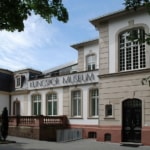 The Klingspor Museum, dedicated to the book arts in the twentieth century, was established in the City of Offenbach in 1953. It took its name from a local industrialist who gifted an important collection of bibliophile editions to the City in 1948. The industrialist in question was Karl Klingspor, the last director of the celebrated type foundry of the same name which had been active in the city since 1892 when his father had bought out the Rudhard’sche foundry. The company had been very successful in the early part of the twentieth century under the direction of Karl and his brother Wilhelm, notably with a succession of typefaces produced by eminent designers such as Rudolph Koch, Walter Tiemann, Otto Eckmann and Peter Behrens. Like many other typefoundries, Klingspor suffered from the introduction of the Linotype and Monotype composing machines which quickly acquired a large part of the market for small-sized text types for books, newspapers and magazines, leaving the traditional foundries increasingly dependent on display faces for titling and advertising. In 1917 Klingspor’s rival, Stempel, based in nearby Frankfurt bought into the firm’s activities and completed the acquisition in 1956 when Klingspor finally closed its doors.
The Klingspor Museum, dedicated to the book arts in the twentieth century, was established in the City of Offenbach in 1953. It took its name from a local industrialist who gifted an important collection of bibliophile editions to the City in 1948. The industrialist in question was Karl Klingspor, the last director of the celebrated type foundry of the same name which had been active in the city since 1892 when his father had bought out the Rudhard’sche foundry. The company had been very successful in the early part of the twentieth century under the direction of Karl and his brother Wilhelm, notably with a succession of typefaces produced by eminent designers such as Rudolph Koch, Walter Tiemann, Otto Eckmann and Peter Behrens. Like many other typefoundries, Klingspor suffered from the introduction of the Linotype and Monotype composing machines which quickly acquired a large part of the market for small-sized text types for books, newspapers and magazines, leaving the traditional foundries increasingly dependent on display faces for titling and advertising. In 1917 Klingspor’s rival, Stempel, based in nearby Frankfurt bought into the firm’s activities and completed the acquisition in 1956 when Klingspor finally closed its doors.
Karl Klingspor had been collecting fine editions for many years and from the 1920s on had commissioned many works from major books artists. Klingspor had also been one of the initiators of the ‘beautiful book competition’ in the 1920s. After the Second World War he had considered giving his collection to Leipzig but had been advised against this by Walter Tiemann who, presciently, was worried about the possible repercussions of the political uncertainty of the time.
In addition to his private collection of bibliophile editions and fine printing of all sorts, Karl Klingspor’s library included many type catalogues, specimens and other house publications issued by his firm over the years.
Today the Klingspor Museum operates in a potentially favourable environment participating in a traditional printing workshop in the nearby Haus der Stadtgeschichte Museum und Archiv (local history museum), and a project to establish a type institute with with the nearby design school to create The International Senefelder Foundation is also based in Offenbach because of the importance of the city in the early development of lithography and its artistic applications. Senefelder settled in Offenbach in the very early years of his invention and collaborated with the music publisher and printer André who was based in Offenbach. The idea of a Senefelder museum was mooted in 1920 but did not come to anything, and the existing collections were given to the City library. The 1930s saw the creation of the design Hochschule and the City’s history museum where the Senefelder material is now preserved. Offenbach is also the site of the large MAN-Roland company’s sheet-fed press factory. MAN’s activities in the heritage field are however concentrated in the firm’s principal manufacturing and administrative centre, Augsburg, in the form of a museum which is largely focused on the history of the firm’s automotive activities.
1955
Musée de l’impression sur étoffes (Museum of textile printing, Mulhouse, France)
Deutsches Spielkartenmuseum (Leinfelden-Echterdingen, Germany)
Founded as a private museum, it subsequently changed hands and was reinstalled in 1972. Taken over by the municipality of Leinfelden-Echterdingen and the region in the mid-1980s.
1956
Iskra Gedenkstätte (Iskra Memorial Site, Leipzig, German Democratic Republic)
Memorial with a small museum for the Communist newspaper Iskra (The spark) which was edited and largely written by Lenin. (Source: Mуэеи книги directory.)
Museo del Libro Antiguo (Antigua, Guatemala)
King Library Press (University of Kentucky, Lexington, Kentucky, United States)
A bibliographical press.
1957
Museum Knihy (Museum of the Book, Ždár nad Sázavou, Czechoslovak Socialist Republic)
Was located inside the castle of Dr. Radslav Kinsky. Closed in 2014.
Múseum revolučnej tlače Klementa Gottwalda v Martine Vrútkach (Czech, Museum of Revolutionary Printing Klement Gottwald and Martin Vrútkac, Vrútky, Czechoslovak Socialist Republic)
1960
Музей Кишинебской подполъной типографии ленинской гаэеты ‘Искра’ (Chişinău Museum of the Clandestine Printing House of the Leninist Newspaper Iskra, i.e. Spark, Kišiniov, Ukrainian Soviet Socialist Republic)
(Source: Mуэеи книги directory.)
1961
ОкрЪжнкой исторически музей. Кооперативная типография Работник (Okr’zhnoi Historical Museum. Co-operative Printing House Работник, newspaper and printing museum, Veliko Tyrnovo, People’s Republic of Bulgaria)
(Source: Mуэеи книги directory.)
Museu Moli Paperer de Capellades (Capellades, Spain)
1962
Internationales Zeitungsmuseum (International newspaper museum, Aachen, Germany)
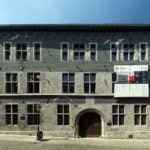 The post-war period was marked by the creation of museums based on ‘non-book’ collections which had been steadily accumulating in libraries since the late nineteenth century and which had begun to acqire a certain visibility. The Internationales Zeitungsmuseum or IZM (international newspaper museum) offers an interesting example of the vicissitudes of such collections and the sometimes long gestation periods of museums. The Internationales Zeitungsmuseum opened its doors in 1962 at Aachen in Germany, on the occasion of the commemoration of Julius Reuter, the founder of the news agency of the same name.
The post-war period was marked by the creation of museums based on ‘non-book’ collections which had been steadily accumulating in libraries since the late nineteenth century and which had begun to acqire a certain visibility. The Internationales Zeitungsmuseum or IZM (international newspaper museum) offers an interesting example of the vicissitudes of such collections and the sometimes long gestation periods of museums. The Internationales Zeitungsmuseum opened its doors in 1962 at Aachen in Germany, on the occasion of the commemoration of Julius Reuter, the founder of the news agency of the same name.
In fact, the origins of the IZM go back to the end of the nineteenth century, to the collection of some 80,000 newspapers which the lawyer, politician, collector and scholar Oskar von Forckenbeck (1822-98) put together over a forty year period. During his lifetime Forckenbeck had organised several exhibitions of newspapers from his collection in order to bring the importance of the Press to the attention of the general public. The first of these was shown in Aachen’s Suermondt-Museum in 1886. Three years later he founded a journal, Das Zeituungsmuseum (the newspaper museum), in collaboration with Max Schlesinger (1846-1919) who ran it alone from 1892 until 1900. Upon the death of Forckenbeck in 1898 his collection, along with 1,500 books on related subjects, were bequeathed to the City of Aachen which, in 1900, opened a reading room in the foyer of the municipal theatre with 300 current German and foreign newspaper titles available for consultation. For the next three decades the existence and importance of the collection were acknowledged, but it was only in 1931 that anything resembling a newspaper museum came into existence when the collection was moved to the Grosse Haus, a fifteenth century mansion house where a certain number of important historical newspapers were put on display.
The opening of the Internationales Zeitungsmuseum in 1962 came after a period of closure and important renovation work. The permanent exibition, which covered four hundred years of newspaper history remained virtually unaltered until 2006 when the City obtained European funding for a further renovation of the Museum and a complete reworking of the permanent exhibition to include other non-print news media. Over the years the collection has continued to grow to become one of the largest in the world with over 200,000 newspapers from all periods and from all over the world.
Kékfestö Múzeum (indigo textile printing museum, Pápa, Hungarian People’s Republic)
Grafisch Centrum Groningen (Groningen, The Netherlands)
The Grafisch Centrum Groningen is an artists’ workshop and exhibition venue.
In the early 1960s, several members of De Ploeg, led by Johann Faber and Jan van der Baan, decided to set up their own graphic workshop. In doing so, they combined their love for graphics with the desire to work together. The presses they brought in are still in use at the centre that facilitates all graphic techniques. In addition to artists working freely, there is a thriving course offering and countless students have become hooked for life on the smell of ink and one or more graphic techniques. The Graphic Centre Foundation is supported and sustained by an enthusiastic group of volunteers, free workers, students and friends. (Source: Grafisch Centrum Groningen.)
1963
Museo Bodoniano (Bodoni museum, Parma, Italy)
The Stanza dei punzo, established in 1843 (see above) to celebrate the work of the célèbre typographe Giambattista Bodoni, was closed sometime before the Second World War, to reappear again in 1963 in the form of the Museo Bodoniano which, larger than its predecessor, brought together all the typographical material, archives and printed works of Bodoni.[1] However, in the world of printing museums having clear objectives and being in possession of an important collection do not guarantee success, for the Stanza dei punzo and its successor the Museo Bodoniano have both suffered various ups and downs over the years despite being backed by an major heritage library. The resources of such libraries being on occasion inversely proportional to the richness of their collections, the Stanza dei punzo lived modestly for nearly a century. It was, after all, only a department―albeit a very prestigious department―of a library and not a museum as such, at a time when libraries generally allocated few resources to the display of their treasures. In addition, its closure to the public sometime in the late 1930s was followed by the disastrous bombardment of the Palatino Library during the Second World War and it was only in 1963 that it reopened, this time as the Museo Bodoniano. But even then, it lived a precarious life, subject to the vagaries of budgets and cultural policies. In the 1980s and 1990s it continued to struggle for resources and was repeatedly refinanced and relaunched. During this time access to the Museum could be something of an obstacle race and visitors in winter would often find their enthusiasm for the treasures of the Bodoni collection tempered by having to walk through unheated rooms.
1963
Bibliothèque Forney (Paris, France)
Fondée en 1886, la Bibliothèque Forney s’installe dans l’hôtel de Sens en 1961 elle organise des expositions dans le domaine graphique à partir de 1963.
1964
Musée de l’imprimerie et de la communication graphique (Museum of printing and graphic communication, Lyon, France)
View photo gallery. Established by the City of Lyon in 1964 as the Musée de l’imprimerie, it changed its name to Musée de l’imprimerie et de la communication graphique in 2014 on the occasion of a major reorganisation of its permanent collection to mark the 50th anniversary of its founding. It is interesting for a number of reasons, including its municipal status and the cross-fertilisation of networks (professional community, libraries, municipality) that led to its creation, for the city of Lyon called on master printer Maurice Audin in 1957 to create a museum celebrating the contribution of printing, books and prints to the progress of European civilisation.
Audin was assisted in the conception of the museum, the creation of the collections and the elaboration of the museum’s narrative by Henri-Jean Martin (1924-2007), who was then coming to the end of a twelve-year stint as a librarian at the Bibliothèque nationale, and by the antiquarian bookseller André Jammes. In 1958, Martin had just published L’apparition du livre which he had begun to co-author with the historian Lucien Fevbre who died two years before the book’s publication. Following the publication of this work, Martin was asked by the Directeur des Bibliothèques et de la Lecture publique, Julien Cain, to give lectures at the École supérieure des bibliothécaires (Villeurbanne, now Enssib). In 1962, he was appointed Curator of Libraries for the City of Lyon, and in 1963, Director of Studies at the École Pratique des Hautes Études (Paris). In other words, during the period when the new Musée lyonnais de l’imprimerie was being designed, he was establishing his position as the leader of a new school of French book history. André Jammes, for his part, is not only a renowned antiquarian bookseller, but also a leading specialist in the history of typography, photography and photomechanical processes. He contributed to the project not only with his encyclopaedic knowledge of antiquarian books, but also by unearthing for the new Museum a large number of more or less rare works of particular interest in terms of their form, content or manufacturing processes and methods.
Martin was delighted to work with Audin, whom he had often met in the Bibliothèque nationale’s reading room when he had worked there, and whose work in the field of printing history he was already familiar with. All the more so because he also felt that the Bibliothèque municipale needed a showcase for its collections. Until his appointment, it had been very inward-looking with few exhibitions. As the curator of a library with one of the largest rare book collection in France, and having already begun to organise exhibitions within the institution, he was happy to be able to contribute to the creation of the Museum, which he felt, moreover, should logically be attached, as a municipal structure, to the library, both from a scientific and administrative point of view.
The idea of a printing museum was backed by the City of Lyon in the person of its Mayor Louis Pradel whom Maurice Audin contacted shortly after the inauguration of an important exhibition at the City Library dedicated to Rabelais during which the Mayor had spoken warmly of Maurice’s scholar-printing father Marius. In his reply Pradel claimed to have been thinking about the possibility of some form of permanent collection dedicated to the history of the book in Lyon following the exhibition. Pradel originally suggested that it be part of the city’s historical museum the Musée Gadagne. However the then curator of the Musée Gadagne, Claude Dalbanne, himself a wood engraver whose work had often been printed by Maurice Audin, was not keen on the idea which was dropped after a somewhat tetchy correspondence exchanged in 1954 with Maurice who fiercely defend the proposed printing museum’s independence.
The Musée lyonnais de l’imprimerie, which opened its doors in 1964, can be seen as a general museum inspired more by the model of the Musée Gutenberg than the Musée Plantin-Moretus. In 2004, Henri-Jean Martin summed up the founders’ approach as follows: ‘In Germany, the cult of Gutenberg is part of children’s education, and Gutenberg is the great German glory. In France, we should understand all the more that our typographic heritage is a treasure to be safeguarded because French typography has shone so brightly for centuries. These are things to which the English [sic] are more attached than we are.’
Originally, the Museum was to include a research section—the studium—with the aim of forging close links with the academic world. However, this wish was only partially realised thirty-five years later, when the Museum took part in the creation, in 2001, of the Institut d’histoire du livre, which brought together the Bibliothèque municipale, the Museum, the Enssib, the École nationale supérieure de Lyon, litérature et sciences humaines (newly relocated to Lyon) and the École nationale des chartes.
As mentioned above, the Musée changed its name—and in part its identity—in 2014 when it became the Musée de l’imprimerie et de la communcation graphique.
National Museum of American History’s ‘Hall of printing and graphic arts’ (Washington, United States)
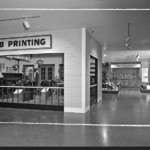 The Smithsonian Institution’s Museum of American History opened a large ‘Hall of printing and graphic arts’ on January 1, 1964. It was drastically reduced in 2003 and specialised personnel was not replaced upon retirement This was followed by problems with asbestos in the storage area containing the printing collections which further limited access.
The Smithsonian Institution’s Museum of American History opened a large ‘Hall of printing and graphic arts’ on January 1, 1964. It was drastically reduced in 2003 and specialised personnel was not replaced upon retirement This was followed by problems with asbestos in the storage area containing the printing collections which further limited access.
Musée Félicien Rops (Namur, Belgium)
Musée consacré à l’œuvre de l’artiste-graveur Félicien Rops. Peintre et dessinateur prolifique, Rops pratiqua aussi la gravure sous toutes ses formes : lithographie, eau-forte, pointe-sèche, aquatinte et héliogravure. Le Musée possède plus de mille gravures ainsi que quelque 400 peintures et un nombre tout aussi important de dessins.
Museo de artes gráficas (Graphic arts museum, Imprenta nacional de Colombia)
View photo gallery. The graphic arts museumof Imprenta Nacional (the Colombian national printing office) was founded by Tarcisio Higuera Barrera on 30 April 1964 on the occasion of the centenary of the Diario Oficial. Its principal missions is to enrich, maintain, document and promote the heritage the country’ graphic heritage. The permanent collection presents various printing techniques, from woodcuts, through letterpress and stone lithography to offset printing. Many of the techniques were used by workers who are still with the company.
company. Printed artefacts include books and other publications from the first printing press in Bogotá, as well as banknotes and postage stamps and other printed ephemera. Originally installed in temporary premises, the Museum is now housed in the new headquarters of the National Printing House.
1966
Muzeum Historyczne m. Krakow. Oddział Historii Drukarstwa i Introligatorstwa (Museum of History of Krakow. Section on the history of Printing and Bookbinding, Krakow, Polish People’s Republic)
(Source: Mуэеи книги directory.)
Muzeul Județean Dîmbovița. Muzeul tiparului si al càrtii vechi românesti (Dîmbovița County Museum. Museum of Romanian Printing and Old Books, Târgovişte, Socialist Republic of Romania)
1968
Muzeum Papiernictwa w Dusznikach-Zdroju (Paper Museum of Dusznikach-Zdroju, Duszniki-Zdrój, Polish People’s Republic)
(Source: Mуэеи книги directory.)
Muzeum plakatu (Poster Museum, Wilanów, Poland)
The world’s first museum dedicated exclusively to posters, set up as a subsidiary of the Warsaw National Museum.
Мемориалъный дом-музей ‘Подполъная типографии Пермского комитета РСДРП 1906 г.’ (Historic House and Museum of the ‘Clandestine Printing House of the Committee of the RSDRP of 1906’, i.e. the Russian Social Democratic Labour Party, Perm, Russian Soviet Federative Socialist Republic)
(Source: Mуэеи книги directory.)
John Johnson collection (Bodleain Library, Oxford, United Kingdon)
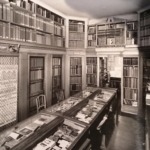 The origins of the John Johnson Collection—one of the world’s most important collections of ephemera, now held by the Bodleian Library in Oxford—date back to the early 20th century.
The origins of the John Johnson Collection—one of the world’s most important collections of ephemera, now held by the Bodleian Library in Oxford—date back to the early 20th century.
John Johnson (1882-1956) became interested in papyrology after a period as a British civil servant in Egypt. Returning to the UK at the start of the First World War, he found a job with the secretariat of the Oxford University Press and, finding it interesting to pay just as much attention to contemporary printed documents as to the papyri which had hitherto attracted his attention, both bear witness to the evolution of albeit very different societies, he began collecting prints of all kinds. In 1925, he was appointed Printer to the University of Oxford, a post he held until his retirement in 1946.
His growing collection was housed by Oxford University Press as the Constance Meade Memorial Collection of Ephemeral Printing (named after one of his benefactors). Johnson continued to add to and study his collection until his death in 1956. He is said to have collected around 1.5 million documents, which he organized into 680 categories covering all periods of print production. The collection was renamed the John Johnson Collection when it was transferred to the Bodleian Library in 1968, where it was regularly exhibited. Ironically, the Bodleian would thus recover much of the printed ephemera it had disposed of thirty years earlier, which had been incorporated into the Johnson collection thanks to the foresight of the curator then in charge of the library’s book collections who had brought the ephemera to Johnson’s attention.
(Photo: Archives of the Oxford University Press.)
1969
Nationaal Museum van de Speelkaart (National playing card museum, Turnhout, Belgium)
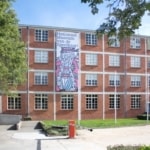 View photo gallery. The Nationaal museum van de speelkaart in Turnhout (Belgium) was the initiative of a group of people who were interested in one of the town’s principal industries. Turnhout was, and remains, a major centre for the production of playing cards. Most of the many companies which once existed in the town have either disappeared or have been absorbed by the last remaining firm which is today one of the world leaders in the field.
View photo gallery. The Nationaal museum van de speelkaart in Turnhout (Belgium) was the initiative of a group of people who were interested in one of the town’s principal industries. Turnhout was, and remains, a major centre for the production of playing cards. Most of the many companies which once existed in the town have either disappeared or have been absorbed by the last remaining firm which is today one of the world leaders in the field.
The group was originally formed with the aimed of setting up a documentation centre and organising temporary exhibitions. The idea emerged of establishing a museum but, curiously, it initially encountered a certain resistance on the part of the handful of playing card firms still operating in the town, perhaps because traditional habits of secrecy still held sway in a trade which was undergoing considerable industrial and commercial rationalisation, with a consequent sharpening of competition. The museum opened in 1969 as an independent organisation, but was later handed over to the town which has run and developed it ever since, extending its collections in 19th and early 20th century printing techniques, playing card finishing techniques, and even adding a complete steam engine such as might have powered the a factory up until the 1930s.
Technisches Denkmal ‘Neumann-Mühle’ (Technological Memorial Neuman Mill, Ottendorf (now part of Sebnitz), German Democratic Republic)
Paper mill museum, today a heritage site dedicated to the history of local timber cutting, the main industry, but also wood pulp and paper production.
Музей нелегалъной печати ЦК КП Латвии (Museum of the clandestine printing house of the Central Committee of the Communist Party of Latvia, Riga, Latvian Soviet Socialist Republic)
(Source: Mуэеи книги directory.)
1970
Městské museum. Historia knihtisku ve Vimperku (Vimperk, Czechoslovak Socialist Republic)
Display on the history of book printing in Vimperk City Museum.
Gyomai Kner Nyomda Zrt. Kner Gyüjtemény (Kner Printing Museum, Kossuth, Hungary
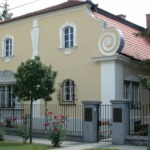 The origins of the Kner printing firm go back to 1882 when Izidor Kner began working as a bookbinder. The business to become a full-blown printing firm under the influence of Izidor’s son Imre who had trained as a printer and who was part of a radical group involved in the Revolution of 1918-19. Imre was also friends with influential European typographers such as the Belgian book designer and teacher Henry Van der Velde and the Offenbach type designer Karl Klingspor. Imre equipped the firm with Monotype machines and the best foundry types from Klingspor and other German foundries. Kner’s firm was reputed for the quality of its work which Imre maintained thanks to his close connexions with leading Hungarian intellectuals, designers and illustrators. On the early death of Imre in 1945, the firm was taken over by the state and continues in operation to the present day. (Bulletin of the Printing Historical Society, n° 17, January 1986, p. 217.)
The origins of the Kner printing firm go back to 1882 when Izidor Kner began working as a bookbinder. The business to become a full-blown printing firm under the influence of Izidor’s son Imre who had trained as a printer and who was part of a radical group involved in the Revolution of 1918-19. Imre was also friends with influential European typographers such as the Belgian book designer and teacher Henry Van der Velde and the Offenbach type designer Karl Klingspor. Imre equipped the firm with Monotype machines and the best foundry types from Klingspor and other German foundries. Kner’s firm was reputed for the quality of its work which Imre maintained thanks to his close connexions with leading Hungarian intellectuals, designers and illustrators. On the early death of Imre in 1945, the firm was taken over by the state and continues in operation to the present day. (Bulletin of the Printing Historical Society, n° 17, January 1986, p. 217.)
In 1970 the family home was made over into to museum which traces the history of the firm and its place in Hungarian and European book design.
The Kner Printing Industry Museum is situated in the former house of Imre Kner, on the same location as the current Printing House. The rustic Baroque style house was designed by Lajos Kozma, and was built in 1925. Since 1970, the museum’s permanent exhibition presents the work of Kner family members and the history of the Kner Printing House from its 1882 founding until today. The press’s own books, art prom invitations, calendars, postcards, posters, stock certificates, various administrative and mercantile forms, contemporary photographs and historical documents are on display. The exhibition includes a fully operable bookbinding and printing press machinery, which can be used for demonstrations. The economic basis of the Gyomai Kner Printing House was the production and distribution of administrative forms, which later expanded into providing stationery to fit the needs of its clients. In the first years of the 20th century the founder, Izidor Kner launched tenders for designing ball invitations for artists, which were judged by a professional jury. He then printed hundreds of pages of the best artworks in his ‘Röpke Lapok’ publication, which also worked as an ordering form and could be used for almost all social events (balls, concerts, ceremonies, etc.).
But the name Kner became known mainly because of his books. The publishing industry has already taken notice of Izidor Kner, but the rise in the quality and the quantity of orders is attributed to his first-born son, Imre Kner. After a brief study in Leipzig, at the age of 17, he became a technical manager for Kner Printing House, and breaking from the traditions and practices of the age invented Baroque typography, which was accompanied by typographical ornaments, initials and printing marks of Lajos Kozma. The three most beautiful historical publications displaying these, are Cseppke Három Books, Kner Classics and the Monumenta Literarum volumes. By using the Bodoni font the neoclassical style characterized the mid-1930s Kner books. In the interwar period, Kner became the hallmark of Hungarian book publishing art at home and abroad: the publications received the highest recognition by the domestic and foreign experts in the fields of printing and typography.
The printing house was nationalized in 1949, and in 1963 it was appended to the Tevan Printing House in Békéscsaba. The Joint venture took up the name Kner Printing House in 1964 and from its headquarters in Békéscsaba established itself as a large corporation, continuously honouring the traditions of their separate pasts. By optimizing multi-site working they prevailed for nearly 30 years. Lajos Kozma furniture Made in 1928, and designed by Lajos Kozma this furniture collection was the property of Zsigmond Szeged and furnished the girl’s room in his Rómer Flóris street apartment. (https://www.dowzr.com/en/pro/the-kner-museum-of-printing-industry.fXke6WCfS6CmzHnFMpI_rA.html 24 March 2018.)
Casa Dosoftei (Dosoftei House, Iasi, Socialist Republic of Romania)
Museum of Romanian literature in the historic building, site of the second printing press in Moldova (1679-1686) where the first printing in the Romanian language occurred. (Source: Mуэеи книги directory.)
1972
Verla Paper Mill Museum (Verla Kouvola, Finland)
The Verla groundwood paper mill, established in 1872, ceased production in 1964. The idea of turning the buildings – coherent ensemble of industrial architecture – into a museum had been raised in the 1950s, but it would be nearly twenty years before the idea was taken up seriously. As the Museum’s website describes it: ‘The official proposal to transform the Verla Groundwood and Board Mill into a factory museum originated with the company that owned it. Kymi Corporation’s communications and public relations manager Veikko Talvi had admired the architecture and milieu of the old industrial settlement already in the early 1950s when he visited Verla for the first time. Talvi had studied history and was particularly impressed with the mill’s machinery and equipment, as well as by the entire production process, which had remained unchanged since the late 19th century. Talvi started to systematically record Verla’s history. He photographed the buildings, the work methods and the personnel. He also interviewed current and retired workers and collected old photographs and other documentary material. At Talvi’s initiative, a documentary about the mill’s operations was filmed during the mill’s final days.’ […] The Mill Museum’s opening ceremony was held on 14 May 1972. It is described as Finland’s first factory museum.
Verla was added to the World Heritage List in 1996 as an outstanding and remarkably well-preserved example of the small-scale rural industrial settlement associated with pulp and board production that flourished in northern Europe and North America in the 19th and early 20th centuries, of which only a handful survive to the present day.
Friedrich Gottlob Keller Heimatmuseum (Friedrich Gottlob Keller Local History Museum, Krippen (now part of Bad Schandau), German Democratic Republic)
Paper history museum. Friedrich Gottlob Keller invented the process for making paper from ground wood pulp in 1843.
Музей книги і друкарства України (Museum of books and printing of Ukraine, Kiev, Ukraine)
The Museum is located in a former building of the the first printing house in Eastern Ukraine, which was housed in the Kyiv Cave Monastery Press (early 17th century) and worked constantly for over 300 years. It was established in Kyiv in 1972 (UNESCO’s International Year of the Book) as the State Museum of the Book and Book Printing, and opened to the public in 1975. The Museum collection contains 58 000 exhibits – manuscripts, old printed books 16th-18th c., engravings, printing presses, first editions of 19th and 20th century Ukrainian books and other publications, bookplates, graphic works and paintings. More than 3000 items exhibited in five halls chronicle the development of book writing, printing and book publishing in Ukraine.
1973
Vallis Clausa (Fontaine-de-Vaucluse, France)
At the request of Jean Garcin, President of the Département of Vaucluse, Marius Péraudeau, founder of the Richard-de-Bas paper mill and curator of the historical museum in Ambert, Auvergne, imagined and created a cultural and craft group in Fontaine-de-Vaucluse with the aim of renovating and safeguarding the last paper mill on the Sorgue. The Moulin de la Fontaine make rag paper by hand and runs a cultural craft centre to promote high quality crafts.
Izba Drukarstwa w Lublinie (Lublin Printing Workshop, Lublin, Poland)
Established after the closure of a local private printing firm. Unfortunately the collections grew faster than the finances could follow and the museum had to close. It was reopenend in 2007. (See 2007.)
1974
Deutsches Plakat Museum (German Poster Museum, Essen, Germany)
As befits a country with a strong tradition in the field, the Deutsches Plakat Museum holds one of the largest poster collections in the world with over 350,000 items covering all periods with a particular emphasis on German posters. It is based on a collection that was set up by the Folkwang School of Design in the 1960s. Opened in 1974 it later became part of the Folkwang Museum (fine arts).
1975
Musée de l’imprimerie / Drukkerijmuseum (Bibliothèque royale Albert 1er (KBR), Brussels, Belgium)
The Museum of Printing (created in 1975, but officially organised as a non-profit association in April 1977) aims to conserve and present important artefacts of the history of printing and bookmaking, as well as collecting documentation relating to these subjects. The museum illustrates the development of printing in Belgium in the 19th century. It brings together cast-iron platen presses, Belgian cylinder presses and ancillary printing equipment, mainly from the 19th and early 20th centuries. Some important items are on display in the corridors of the Bibiolthèque royale Albert 1er. Other objects are not currently accessible to the public. The museum has a specialised library of around a thousand books which can be accessed via KBR’s online catalogue and consulted in the general reading room.
Музей ВЪзражданете и национално-освободителните борби Материали за делотона Х.Г. Данов (Museum on V’zrazhdanete and the National Liberation Party Propaganda Materials for the case on H.G. Danov, Plovdiv, People’s Republic of Bulgaria)
Now part of Plovdiv Regional History Museum. (Source: Mуэеи книги directory.)
Lahti poster museum, Lahti, Finland
The Poster Museum was established as part of the Lahti Art Museum in Autumn 1975 with the aim of collecting and studying Finnish and foreign graphic design. The collections have been augmented mainly through donations but also through purchases and deposits and contain approximately 60 000 prints, most of which are posters. The Museum was integrated with the Lahti art museum a museum of visual arts under the name Malva and is located in downtown Lahti, about an hour’s train ride from Helsinki, in the Malski Centre that has been built in an old brewery.
Grafisch Museum In den Groenen Zonck (Wouw, Netherlands)
The museum originated with a private collection which has since been enriched by various donations. It takes its name from the building in which it is housed: the Groenen Zonck.
Heron Corn Mill and Museum of Paper Making (Beetham Milnthorpe, United Kingdom)
A working, water-driven corn mill acquired by the local papermaker Henry Cooke Ltd who formed Beetham Trust, a charity whose members began the task of restoring the mill and its machinery. There is an exhibition of 900 years of milling and a gallery devoted to baking. The museum shows papermaking ancient and modern. There are demonstrations of the handmaking of paper.
1976
 Nederlands drukkerik museum (Etten-Leur, The Netherlands)
Nederlands drukkerik museum (Etten-Leur, The Netherlands)
Cooper Hewitt (New York, United States)
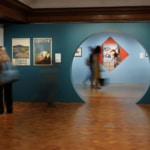 Cooper Hewitt is a design museum. So it is not a printing museum nor even a graphic design museum as such. But like all the major museums of the decorative arts it devotes a lot of its energies to graphic design and printed products. Its origins go back to 1859 and the establishment of the Cooper Union for the Advancement of Science and Art as an institution of higher learning which was intended to also include a museum. Inspired by the Victoria and Albert Museum in London and the Musée des arts décoratifs in Paris, the museum only actually came into being in 1897. In 1963, the Cooper Union’s announcement that it was going to disband the Museum for financial reasons provoked an outrcy and a campaign to prevent its collections going into storage and maintain them as a publicy available resource. The result was the creation of the Cooper-Hewitt Museum as part of the Smithsonian Institution which opened to the public on the 7th October 1976.
Cooper Hewitt is a design museum. So it is not a printing museum nor even a graphic design museum as such. But like all the major museums of the decorative arts it devotes a lot of its energies to graphic design and printed products. Its origins go back to 1859 and the establishment of the Cooper Union for the Advancement of Science and Art as an institution of higher learning which was intended to also include a museum. Inspired by the Victoria and Albert Museum in London and the Musée des arts décoratifs in Paris, the museum only actually came into being in 1897. In 1963, the Cooper Union’s announcement that it was going to disband the Museum for financial reasons provoked an outrcy and a campaign to prevent its collections going into storage and maintain them as a publicy available resource. The result was the creation of the Cooper-Hewitt Museum as part of the Smithsonian Institution which opened to the public on the 7th October 1976.
Roy Chatters “Boomerang” newspaper & printing museum (Palouse, Washington State, United States)
The museum operated until 1996 when a city flood caused damage to the wooden floor. The museum reopened in 2003 after a massive volunteer effort repaired the building and restored its contents.
1977
Musée de la Toile de Jouy (Jouy-en-Josas, France)
Manawatu Printery Collection at the Manawatu Museum (Palmerston North, New Zealand)
The Manawatu museum was established in 1970 and in 1975 was rehoused in a museum complex provided by the Palmerston North City Council. The Museum Printery was established in 1977 and then was housed in a small wooden building within the museum complex. The first Manawatu Museum printer was John Brebner, a significant figure in the region for his work in keeping the tradition of letterpress printing alive—and not just through his work as the Manawatu Museum Printer. As an art teacher in a local school he involved his students in printing activities. In addition he ran his own private press, printmaking studio and workshop, Homeprint, providing resources and training in printing locally and beyond. (Source: Shadowland Newsletter, n°131.)
Централъные музей В.И. Ленина. Создание и распространение газеты “Искра”, 1901-1903 гг. (Central Museum of V.I. Lenin)
Музей Ивана Федорова (Ivan Federov Museum, Lviv, Ukrainian Soviet Socialist Republic)
1978
Printing and papermaking gallery of the Science Museum (London, United Kingdom)
The Science Museum had exhibited print-related objects since the late 19th century. Then, in 1973, a special section of the Museum was dedicated to printing. That same year the French trade magazine Caractère reported that Eliot Viney, a member of the board of the printing employers’ association who was involved in setting it up, reckoned that it was already outdated because it did not reflect recent changes within the industry and or its current technical capacities. Viney proposed that a new committee be set up to design a more modern display with the help of the industry’s machine manufacturers. (Caractère, May 1973, p. 25.)
In 1978 a large printing and paper gallery was inaugurated. The exhibition included a representation of an 18th century printer’s workshop with a common press which had entered the Museum’s collections in 1863. (John E. Smart, ‘The wooden common press at the Science Museum, London’, Journal of the Printing Historical Society, n° 15, 1980/81, p. 81.)
The Printing and papermaking gallery was closed in 2004, victim, no doubt, of the exhibition’s subsequent relative immobility in the face of the profound transformations affecting graphic techniques from the 1980s onwards, and the general enthousiasm for new means of communication, particularly audiovisual. This did not prevent the Museum from acquiring a rotary newspaper press from Fleet Street which was reassembled at its Wroughton airfield storage facility near Swindon.
Musée de l’affiche / de la publicité (Museum of advertising, Paris, France)
Musée de l’affiche was founded in 1978 in Paris under the auspices of the Union centrale des arts décoratifs. Its collections, described by the printing trade press of the time as being ‘unique au monde’, included 40,000 posters from France and abroad, the fruit of bringing together of various private collections. It opened to the public in 1981 in its own premises. The subsequent development of the Musée is interesting for it reflects the profound changes which the printing industry was undergoing at that time. France had been one the pioneers of illustrated advertising posters at the end of the nineteenth century, a position which it maintained until after the Second World War, and a claim to fame which had been constantly reiterated for nearly a century both by art historians and by the printing trade itself. By the 1980s however, the traditional poster technique of chromilithography had given way to photomechanical processes except in a few specialised fields such as cinema posters and the last of the great French poster artists were being quietly forgotten as photographic images invaded all forms of advertising imagery. This situation certainly encouraged the decision to rename the museum the Musée de la publicité. It was soon to close however. In the face of threats to disperse its collections among various museums a committee was set up to save the Museum in 1989, but to no avail for it closed the following year. Its collections were later integrated within the Musée des arts décoratifs where it reopened in 1999. The Musée des arts décoratifs had itself been collecting posters since the beginning of the 20th century.
Museum of printing (Haverhill, Massachusetts, United States)
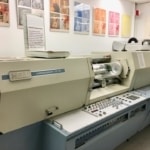 View photo gallery. The Museum of printing was incorporated in 1978 as the Friends of the Printing Museum Inc., to save and preserve printing equipment and library materials associated with the graphic arts. The fact that it of printing was set up in the Boston area was influenced by the proximity of two major manufacturing firms in the field of phototypesetting: Photon and Compugraphic. Photon was the pioneer of second-generation phototypesetting in the 1940s and 1950s. Compugraphic was founded by the original financiel backer of the Photon machine in the United States, William Garth III, who was ousted from Photon in 1960. Garth went into computer typesetting before bringing out a series of simple and cheap phototypesetters which radically transformed the market, bringing phototypesetting within the reach of small and medium-sized firms.
View photo gallery. The Museum of printing was incorporated in 1978 as the Friends of the Printing Museum Inc., to save and preserve printing equipment and library materials associated with the graphic arts. The fact that it of printing was set up in the Boston area was influenced by the proximity of two major manufacturing firms in the field of phototypesetting: Photon and Compugraphic. Photon was the pioneer of second-generation phototypesetting in the 1940s and 1950s. Compugraphic was founded by the original financiel backer of the Photon machine in the United States, William Garth III, who was ousted from Photon in 1960. Garth went into computer typesetting before bringing out a series of simple and cheap phototypesetters which radically transformed the market, bringing phototypesetting within the reach of small and medium-sized firms.
Opened in custom-built premises in September 2016, the Museum’s collections include an important collection of machines and materials relating to phototypesetting as well as nineteenth and twentieth century printing presses, hot-metal linecasters, an electronic colour scanner, wood and metal type and two graphic arts libraries of considerable interest to designers and historians. Read more about the Printing Museum.
1979
Conservatoire des arts et industries graphiques (Paris, France)
In 1979 a group of French industrialists, typographers and historians put forward a project to promote French type design which was at the time in the doldrums following the closure of the country’s three principal type foundries. The original group included Roger Druet, Roger Excoffon, Adrian Frutiger, Marcel Jacno, José Medoza and Rémy Peignot and was chaired by Charles Peignot. It was extended to include other personalities from the graphic design world such as Fernand Baudin, Gérard Blanchard, Raymond Gid, Ladislas Mandel, Claude Médiavilla, Jérôme Peignot and René Ponot. The group’s proposition drew initial support from the Imprimerie nationale and, after the election of François Mitterrand as President in May 1981, of the Ministry of Culture and its emblematic minister Jack Lang. It also resulted in the opening of the Atelier national de creation Typographique in Paris in 1985 to train young type designers. Another aspect of the project was the creation of a Conservatoire des arts et industries graphiques which would include a museum and research facilities, and which would organise events aimed at promoting all aspects of printing. Discussions were pursued over a period of two years with a view to installing it in the Cité des sciences et de l’industrie at La Villette in Paris. In the end the museum project was abandoned. The type designer training programme continues to flourish today under a new name – the Atelier national de recherche Typographique – under the aegis of the School of Art in Nancy.
Fries grafische museum (Joure, Netherlands)
Was initially part of the Fries museum in Leeuwarden. Later became part of the Joure Museum in the nearby town of the same name. It was relaunched in 1999 as a working museum.
Bibelmuseum (Bible museum, Pferdegasse, Germany)
Association pour le patrimoine industriel (Geneva, Switzerland)
1980
Basler Papiermuhl (Basel paper mill, Basel, Switzerland)
In Switzerland the Basler Papiermuhl is situated in a large papermill on the banks of the Rhine in the city of Basle. Opened in 1980 it is run by the private Basel Paper Mill Foundation, established 1971, and is housed in the buildings of the Galician and the Stegreif Mills which were restored in 1980 by the Christoph Merian Foundation and transferred to the Basel Paper Mill Foundation for the creation of the museum. The museum is supported by the Christoph Merian Foundation and by the cantons Basel-Stadt and Basel-Landschaft. It is also known as the Swiss Museum for Paper, Writing and Printing, and in German the Schweizerisches Museum für Papier, Schrift und Druck.
1981
Musée Théophraste Renaudot (Loudun, France)
The Musée Théophraste Renaudot was set up to celebrate the memory of the local-born man who is generally credited with having started the first French newspaper.
Museu del Llibre i les Arts Gràfiques (Book and Graphic Arts Museum Barcelona, Spain)
The collection which formed the basis of this museum had been building up since 1968 within the Museu d’Indústries i Artes populaires under the direction of Enric Tormo who was particularly attentive to material which was generally considered to be of little interest by historians of the time, and who had been adding printed products and machines from Catalan printers to the collections of the popular printmaking section of the Museu d’Indústries i Artes populaires. By 1974 the collection had begon to take on a life of its own. The collection gained in visibility with the opening in 1981 of the Museu del Llibre i les Arts Gràphiques, which was renamed the Museu de les Arts Gráfiques in 1989. In the late eighties the City of Barcelona considered the possibility of installing it in new premises in the former Sants factory known as ‘Vapor Vell’, a project which was in the end abandoned. It closed its doors and was put into storage in 1994, by which time the City had begun to look at the possibility of coordinating its various collections in the broad field of the decorative arts, including their graphic design collections. A large part of its collections now form part of the Barcelona Design Museum which opened in 2014.
Banknote museum of the Ionian Bank (Corfu, Greece)
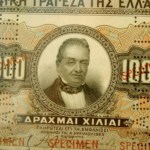 View picture gallery. Banknote museums offer examples of museums which possess important printing heritage collections, often with important displays of printing techniques, but which would not spontaneously identify themselves as printing museums. As its name suggests, The Banknote Museum of the Ionian Bank on the Greek island of Corfu was set up and is entirely maintained by a commercial enterprise—the Ionian Bank—and like others in this sector it is more naturally close to the banking and financial sector that to traditional printing museums or even to printing heritage.
View picture gallery. Banknote museums offer examples of museums which possess important printing heritage collections, often with important displays of printing techniques, but which would not spontaneously identify themselves as printing museums. As its name suggests, The Banknote Museum of the Ionian Bank on the Greek island of Corfu was set up and is entirely maintained by a commercial enterprise—the Ionian Bank—and like others in this sector it is more naturally close to the banking and financial sector that to traditional printing museums or even to printing heritage.
Banknotes from the beginnings of the Ionian Bank, the region’s principal bank in the nineteenth century, until the present day occupy most of the displays. But a significant place is given over to the engraved plates which were used to print them. Read more about the Banknote Museum of the Ionian Bank.
1982
Druckmuseum (Graz, Austria)
Closed in 1999 it now exists only as a virtual, online museum.
Musée de la Presse (Paris, unrealised project)
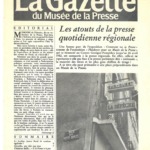 A wonderful idea championed by Christian Bailly from 1982 until his death in 2002. Unfortunately it never came to fruition despite strong political support from the Paris City Council and numerous illustrious patrons in the media world. Bailly, heir to a gigantic collection of newspapers, advertising materials and other documents and himself a great collector and connoisseur of the history of the press, was also the founder in 1976 of a well-known boutique, La Galcante, which dealt in old and modern newspapers and magazines. The idea of the museum was popularized by a major exhibition (75,000 visitors) at the Paris Stock Exchange, during which several issues of La Gazette du Musée de la Presse were published. The Cité de la Presse, whose concept was subsequently championed by professional bodies, also failed to materialize.
A wonderful idea championed by Christian Bailly from 1982 until his death in 2002. Unfortunately it never came to fruition despite strong political support from the Paris City Council and numerous illustrious patrons in the media world. Bailly, heir to a gigantic collection of newspapers, advertising materials and other documents and himself a great collector and connoisseur of the history of the press, was also the founder in 1976 of a well-known boutique, La Galcante, which dealt in old and modern newspapers and magazines. The idea of the museum was popularized by a major exhibition (75,000 visitors) at the Paris Stock Exchange, during which several issues of La Gazette du Musée de la Presse were published. The Cité de la Presse, whose concept was subsequently championed by professional bodies, also failed to materialize.
Musée du dessin et de l’estampe originale (Museum of drawing and printmaking, Gravelines, France)
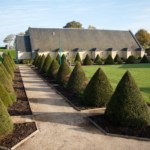 View photo gallery. The Musée du dessin et de l’estampe originale was founded in the small town of Gravelines in the North of France in 1982. This municipal museum is located in the former arsenal of the fortified town and is the only French museum entirely dedicated to prints and printmaking with a collection of some 21,000 documents covering the fifteenth to the twenty-first century.
View photo gallery. The Musée du dessin et de l’estampe originale was founded in the small town of Gravelines in the North of France in 1982. This municipal museum is located in the former arsenal of the fortified town and is the only French museum entirely dedicated to prints and printmaking with a collection of some 21,000 documents covering the fifteenth to the twenty-first century.
Diósgyőri Papírgyár Zrt (Museum of DIPA – Diósgyőr Paper Factory Zrt., Miskolc, Hungary)
Company museum based on artefacts from the the Dipa Inc. paper mill, producers of security papers.
The Japan Ukiyo-e Museum (Shinkiri, Shimadachi, Nagano-ken, Japan)
A privately-owned museum dedicated to Japanese prints.
Muzeum Historyczne m. Krakow. Oddział Historii Drukarstwa i Introligatorstwa (Museum of History of Krakow. Section on the history of Printing and Bookbinding, Krakow, Polish People’s Republic)
In 1982, the local history museum opened a permanent exhibition dedicated to the history of Kraków’s arts of bookbinding and printing, names after and in the former workshop of Robert Jahoda. After the building was recovered by its previous private owner in 1992, the exhibition was moved to the main museum in ‘Krzysztofory’ palace.
John Jarrold printing museum (Norwich, United Kingdom)
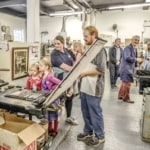 The John Jarrold Printing Museum opened in 1982, taking its name from the man who founded the printing firm of the same name in 1761. In 1910 it changed over from letterpress to offset litho. Then in 1963 it added several web-offset presses to complement its existing sheet fed presses. In the photoengraving department it moved quickly into electronic scanning techniques – initially analogue, later digital – acquiring three Klischograph scanners and a Magnascan (Crosfield) and a Cromalin colour proofing system. In the early 1980s the firm was still flourishing, having gone through several periods of major technical change. These were days when firms like Jarrold could have a full production line from prepress to finishing and bookbinding.
The John Jarrold Printing Museum opened in 1982, taking its name from the man who founded the printing firm of the same name in 1761. In 1910 it changed over from letterpress to offset litho. Then in 1963 it added several web-offset presses to complement its existing sheet fed presses. In the photoengraving department it moved quickly into electronic scanning techniques – initially analogue, later digital – acquiring three Klischograph scanners and a Magnascan (Crosfield) and a Cromalin colour proofing system. In the early 1980s the firm was still flourishing, having gone through several periods of major technical change. These were days when firms like Jarrold could have a full production line from prepress to finishing and bookbinding.
The Museum was closed in 2019 due to redevelopment. After a short period of uncertainty as to the future of its important collections it reopened as the Norwich Printing Museum in July 2021. (See Norwich Printing Museum.)
The Printing Museum (Houston, Texas, United States)
1983
Musée du papier peint (Wallpaper museum, Rixheim, France)
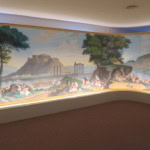 The museum has a display of various wallpaper printing machines as well as very extensive collections of wallpaper products notably those of the Zuber company (around 100,000 items, from the beginning of the 19th c. to 1983) and thousands of wallpapers acquired since 1983. The Musée, which is housed in the Rixheim Commanderie, a listed building, was closed in 2023 for up to 24 months for extensive work to improve the conditions of conservation of the collections.
The museum has a display of various wallpaper printing machines as well as very extensive collections of wallpaper products notably those of the Zuber company (around 100,000 items, from the beginning of the 19th c. to 1983) and thousands of wallpapers acquired since 1983. The Musée, which is housed in the Rixheim Commanderie, a listed building, was closed in 2023 for up to 24 months for extensive work to improve the conditions of conservation of the collections.
Matou (Musée de l’affiche de Toulouse, Toulouse, France)
The collection was started in 1978 but was not open to the public until the Centre de l’affiche opened in 1983. It was refurbished and reopened in April 2017 as the Matou.
Museum Stichting Lettergieten 1983 / Museum Typefoundry Westzaan (Westzaan, Netherlands)
Grafisch museum/atelier ‘In den Groenen Zonck’ (Wouw, Netherlands)
Госвдарственная ордена Пенина библиотека СССР им. В.И. Пенина. Mуэеи книги
(Lenin State Library of the USSR. Museum of the Book, Moscow, Russian Soviet Federative Socialist Republic)
Západoslovenské múzeum v Trnave. Múzeum kniżnej kultúry (Western Slovak Museum in Trnava. Museum of Book Culture, Trnava, Slovak Republic)
Rosenlöfs Tryckerimuseum (Kungsgården, Sweden)
In 1886, 19-year-old Helmer Rosenlöf started a printing business in the basement of his parents’ home in Rosentorp, the property opposite the printing building that now houses the museum’s reception and exhibition space. The printed matter produced was mainly business cards and letterheads, but Helmer found it difficult to make the business profitable. He wrote to his brother Ruben Rosenlöf, five years his senior, who at the time was the crown governor of Bergsjö in Hälsingland, asking him to move home and help with the printing business. Ruben honoured his brother’s request and the brothers then ran the company together.
In 1890, Bröderna Rosenlöf’s Accidenstryckeri AB was founded, still producing small printed items such as business cards, letterheads and advertising leaflets. In 1896, Helmer Rosenlöf died at the age of 29, but Ruben continued the business and began to expand the company. In 1900 he built a completely new printing building, the same that now houses the museum. Modern machines for both printing and bookbinding were purchased, some of which remained in operation until the firm’s closure in 1974.
Today, many visitors ask why Ruben Rosenlöf chose to locate what was then such a large company in the ‘countryside’ on the outskirts of Kungsgården. The explanation is that at that time Ovansjö was a large municipality and Kungsgården with, among other things, Ovansjö church was the centre of the parish. In 1857 the Gävle-Dala railway opened the line between Gävle and Storvik, which made the location of the printing house a few hundred metres from the newly built railway station optimal considering that the transports of that time were largely done by rail.
The company grew rapidly, specialising in the production of business registers and stationery and the number of printing presses was increased. In 1909, an extension was made to the printing building, which now also had a typesetting section and a paper warehouse. Two large cylinder presses were also purchased from Eickhoff in Denmark, and these machines are often demonstrated to visitors. In 1913, the old steam engine, which had previously supplied power via belt drives to the presses, was replaced by an electric motor. Electric lighting was installed.
Ruben Rosenlöf ran the company until 1938 when, for health reasons, he offered eight of his employees to take over the operation. Ruben died in December that year and the new owners invested SEK 2,000 each in share capital and also received shares in proportion to their years of employment.
In 1968 the company began to experience financial problems and the business was running at a loss. During the company’s earlier history, all the text had been typeset by hand, but in 1970 a second-hand typesetting machine was purchased to increase the speed of production, but technological had already overtaken the old printing plant. (Source: https://sv.wikipedia.org/wiki/Rosenl%C3%B6fs_tryckerimuseum.)
Offset technology had arrived, many of the workers were old and it was not longer profitable to use the old letterpress technology. So one day in 1974 the workers just went home, leaving the print shop intact, and they did not come back. Many years later someone began thinking of making a museum out of the print shop. The museum opened in 1983. Specialists from other other museums who took an interest in the project underlined the importace of leaving the printing works exactly as it was so that visitors could see it just as if the workers had gone home on Friday evening and would be coming back on Monday morning.
So now visitors to the museum go back in time over 100 years to see hand type-setting, old letterpress printing and traditional book-binding techniques. The machines are still in working order, though they do not run so often now, the problem being that there are not so many people left who cas still operate the old machines. (Source: Solvig Aho, Rosenlöfs Tryckerimuseum)
1984
Centre de la gravure et de l’image imprimée (La Louvière, Belgium)
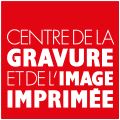 The Centre de la gravure et de l’image imprimée was established at La Louvière in Belgium in 1984, the idea of creating a centre dedicated to prints and printmaking having been initially approved by the local city council in 1979. Then in 1988 it moved into its current premises, a former industrial building which had been built at the beginning of the century and which had been entirely renovated for the Centre de la gravure et de l’image imprimée a not-for-profit association. The three storeys of exhibition, storage and office space were extended and renovated in 2011 in order to meet modern requirements for the conservation and display of graphic documents.
The Centre de la gravure et de l’image imprimée was established at La Louvière in Belgium in 1984, the idea of creating a centre dedicated to prints and printmaking having been initially approved by the local city council in 1979. Then in 1988 it moved into its current premises, a former industrial building which had been built at the beginning of the century and which had been entirely renovated for the Centre de la gravure et de l’image imprimée a not-for-profit association. The three storeys of exhibition, storage and office space were extended and renovated in 2011 in order to meet modern requirements for the conservation and display of graphic documents.
Denmarks mediemuseet (Danish Media Museum, Odensee, Denmark)
View photo gallery. The Media Museum (Danmarks Mediemuseum is a media history museum in Odense, Denmark. Originally known as the Danmarks Grafiske Museum (Danish Graphic Museum) it changed its name in 2006 on the occasion of a major makeover. The Media Museum opened in 1984 at Brandts Klædefabrik. In 1989, the museum merged with the Danish Press Museum and Archive. In 2013, the Media Museum became part of Museum Odense. The museum is focussed on Danish media history and the technological development that the media has undergone throughout the 20th century and the beginning of the 21st century. The development was illustrated by exhibiting and comparing newspapers, magazines and press photographs from different time periods, as well as exhibiting original printing presses, radio and television sets. In 2019, the Media Museum moved to the Møntergården complex. (https://da.wikipedia.org/wiki/Mediemuseet)
Naturhistorisches Museum Schloss Bertholdsburg. Abteilung der Papierindustrie (Natural History Museum Castle Bertholdsburg. Section for the Paper Industry, Scheusingen, German Democratic Republic)
Paper-making section in a typical castle museum. There is no mention of papermaking now although the section may still exist.
Museo della Carta e della Filigrana (Museum of paper and watermarks, Fabriano, Italy)
The Museo della Carta e della Filigrana was established in Fabriano (Italy, 1984), the historic centre of papermaking in Europe, complete with a facsimile of a water-powered papermill.
Издателъство ‘Книга’. Музей миниатурной книгн (Publishing House Kniga. Museum of Miniature Books, Moscow, Russian Soviet Federative Socialist Republic)
(Source: Mуэеи книги directory.)
Музей издателъства ‘Молодая гвардия’ (Museum of the Publishing House ‘Young Guard’, Moscow, Russian Soviet Federative Socialist Republic)
(Source: Mуэеи книги directory.)
Sala Temàtica d’Arts Gràfiques de la Diputació de Lleida (Graphic arts exhibition of Lleida Regional Council, Lleida Catalonia, Spain)
Museo Fournier de Naipes (Fournier playing card museum, Vitoria-Gasteiz, Spain)
The presence of playing cards on the printing heritage scene—already represented by the Deutsches Spielkartenmuseum in Leinfelden-Echterdingen, Germany since 1955 and the Nationaal Museum van de Speelkaart in Turnhout (1969)—was reinforced by the creation of in Spain the Museo Fournier de Naipes (Fournier playing card museum) which was established in 1984 in the town of Vitoria-Gasteiz.
Fondation Claude Bellanger (Martigny, Valais, Suisse)
A documentation and research centre for the press, based on the valuable newspaper collection (80,000 graphic documents of all kinds) assembled over the years by Claude Bellanger (1910-1978), who was the first director of Le Parisien Libéré, president of the International Federation of Newspaper Publishers (FIEJ) and an important historian of the press. His collection was moved to Martigny in Switzerland, where it became the Claude Bellanger Foundation, set up in 1984 by Christine Arnothy, Claude Bellanger’s widow, and their son François Bellanger, a lawyer and professor at the University of Geneva, with the aim of showcasing this immense documentation. The Foundation, inaugurated on 15 September 1989 by François Mitterand, was dissolved on 30 September 2022.
Museum of brands, packaging and advertising (London, United Kingdom)
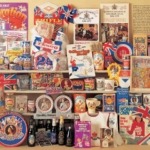 Set up by the consumer historian Robert Opie it pened in Gloucester as the Museum of packaging and advertising and has gone from strength to strength ever since. It moved to London in 2005—at which time it adopted its current name, the Museum of Brands, Packaging and Advertising—and then moved again to larger premises in 2015.
Set up by the consumer historian Robert Opie it pened in Gloucester as the Museum of packaging and advertising and has gone from strength to strength ever since. It moved to London in 2005—at which time it adopted its current name, the Museum of Brands, Packaging and Advertising—and then moved again to larger premises in 2015.
William Clowes printing museum (Beccles, Suffolk, United Kingdom)
This museum is now definitively closed.
1985
Musée Louis Jou (Baux-de-Provence, France)
Museum dedicated to the life and work of the all-round printer, type maker, wood engraver, designer and publisher-bibliphile Louis Jouwho, until his death in 1968, ran his own workshop which over the years evolved into a printing museum. The ‘Friends of Louis Jou’ association was founded in 1965 and on the death of Louis Jou in 1968, his widow maintained his workshop in operation until 1997. The Association became a foundation in 1976.
Museum der Arbeit (Hamburg, Germany)
Its printing section began its public activities in this year.
Museum für Fotokopie (Mülheim an der Ruhr, Germany)
Its collection of copying machines and documentation was integrated into the Deutsches Technikmuseum Berlin in 1999.
Read more : A museum of the photocopier? Outrageous! by Jürgen Wegner.
Beamish open air museum (Beamish, United Kingdom)
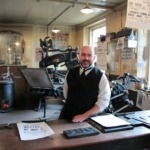 Founded in 1970, the Museum included a print workshop and branch office of the Sunderland daily echo as part of the ‘town area’ which was officially opened in 1985.
Founded in 1970, the Museum included a print workshop and branch office of the Sunderland daily echo as part of the ‘town area’ which was officially opened in 1985.
1986
Imprenta municipal — Artes del libro (Madrid, Spain)
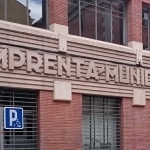 View photo gallery. Centre for the preservation of the history of printing with a permanent exhibition ‘Printing and the book: a story’ which offers the public a view of its extensive collections rich in examples of fine printing with a particular accent on the art and craft of bookbinding which form an ideal complement to its display of mostly nineteenth and early twentieth century printing techniques.
View photo gallery. Centre for the preservation of the history of printing with a permanent exhibition ‘Printing and the book: a story’ which offers the public a view of its extensive collections rich in examples of fine printing with a particular accent on the art and craft of bookbinding which form an ideal complement to its display of mostly nineteenth and early twentieth century printing techniques.
One temporary exhibition is usually scheduled each year in addition to public demonstrations, lectures, and other activities. It also runs professional workshops of typesetting, printing and bookbinding. The tradition of master/pupil has been used to develop hybrid resources used partly for mediation and transmission and partly for production. The Museum, which was formerly the City’s municipal printing office — hence its name — maintained part of the traditional activity of the one-time municipal printing office since its decline in purely commercial terms in the 1980s. The decision to preserve part of this heritage in the transition from workshop to museum benefitted from increasing awareness of heritage in general and intangible heritage in particular in Spain at this time. Thus, while administrative printing was progressively abandoned, certain more specialised bookbinding activities were maintained. The courses that the Museum offers are above all practical, with very little theory or history. A generation of young bookbinders has been trained, which in due course helped the Imprenta Municipal to perpetuate the techniques in a museum context.
Museu de l’Estampació (Premià de Mar, Spain)
Musée de l’imprimerie / ateliers & conservatoire des métiers du livre et de l’estampe (Nantes, France)
The Musée rebranded in the Spring of 2022 to become the Musée-atelier de l’imprimerie.
Musée Champollion. Les écritures du monde (Figeac, France)
Originally opened as the Musée Champollion it was enlarged and reopened in 2007 with the subtitle ‘Les écritures du monde’.
Fjeld-Ljom newspaper museum (Pressemuseet Fjeld-Ljom, Røros, Norway)
The Fjeld-Ljom Newspaper Museum at Røros in Central Norway is situated in the original premises of the former Fjeld-Ljom newspaper, and includes the original editorial office and typesetting and printing departments. The technology is hot metal typesetting and letterpress printing, as was the case when Fjell-Ljom closed in the mid 1970s. The machinery is kept in working condition by voluntary work of experienced craftsmen. Every year a four-page broadsheet newspaper is typeset and printed at the premises.
Государственные историко-кулътурный заповедник города Острога. Отдел истории книгн и книгопечатания (State Historical and Cultural Reserve of the City of Ostrog. Department of Books and Book Printing)
A rare book department only? (Surce: Mуэеи книги directory.)
American advertising museum (Portland, Oregon, United States)
Dedicated to advertising from the 18th century till the present day, it had closed down by 2004.
1987
Dagbladmuseum (Antwerp, Belgium)
Ouvert en 1987 par George Blommaert dans une petite maison appelée à l’époque « de Gulde Handt » (la main d’or) où, à partir du 27 juin 1629, Abraham Verhoeven avait publié le premier journal belge, la Wekelijcke tijdinghe. Fils d’imprimeur Blommaert y avait installé son énorme collection de journaux de tous pays et de toutes époques, des dossiers de presse et quelques presses anciennes, et y organisait des expositions thématiques. Après une période de succès et d’expansion — jusqu’à quatre millions de journaux, dont il était fait commerce — qui avait même conduit à occuper un autre bâtiment moderne adjacent, diverses difficultés conduisirent G. Blommaert à se replier sur la maison d’origine en 2002. Il transféra alors la majeure partie de ses collections dans sa propre demeure à Artselaar au sud d’Anvers. Le site de Lombardenvest fut également fermé et vendu peu après. Le musée a végété pendant quelques années à Artselaar.
Museu casa de xylografía (Xylography Museum, Campos do Jordão, State of São Paulo, Brazil)
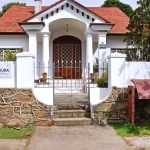 Privately-owned, the Museu casa de xylografía (Xylography Museum) was set up by a collector, Antonio Costella, in the small town of Campos do Jordão in the State of São Paulo, Brazil in 1987. Still going strong thirty years later it is sponsored by the Editora Mantiqueira (Mantiqueira Publishing House) and possesses a rich international collection of wood cuts and engravings with a strong emphasis on Brazil and South America. Interestingly, the founder of the Casa, a former professor in the fields of law and communication history, has willed the building and its collection to the State University of São Paulo which has been an invaluable source of advice over the years.
Privately-owned, the Museu casa de xylografía (Xylography Museum) was set up by a collector, Antonio Costella, in the small town of Campos do Jordão in the State of São Paulo, Brazil in 1987. Still going strong thirty years later it is sponsored by the Editora Mantiqueira (Mantiqueira Publishing House) and possesses a rich international collection of wood cuts and engravings with a strong emphasis on Brazil and South America. Interestingly, the founder of the Casa, a former professor in the fields of law and communication history, has willed the building and its collection to the State University of São Paulo which has been an invaluable source of advice over the years.
Velké Losiny paper mill (Velke Losini, Czeck Republic)
Bruunshaab Gl. Papfabrik (Viborg, Denmark)
A working papermuseum.
Musée des métiers de l’imprimerie (Bordeaux, France)
The idea of setting up an living printing museum to safeguard the memory and techniques of printing was first put forward by Claude Chauffeteau in 1979. The following year, in December 1980, an association was founded, called Les Amis de l’Histoire et des Techniques de l’Imprimerie (friends of the history and technique of printing). The city of Bordeaux made available 1,500 m2 of disused industrial premises (a coffee roasting workshop) at 8-10 rue Fort-Louis to house the future museum. The Musée was formally inaugurated as the Maison des métiers de l’imprimerie by the Mayor of the city of Bordeaux in 1987.
Musée des papeteries Canson et Montgolfier (Annonay, France)
Set up by the firm of Canson & Montgolfier in the original family home of the Mongolfiers on the site of the papermill at Annonay, France.
Printing Historical Museum (Sugito-cho, Saitama Prefecture, Japan)
Set up by the Toppan Printing Research Institute, it was the predecessor of The Printing Museum, Tokyo (2000).
Museo de la Imprenta y la Obra Gráfica (Museum of printing and the graphic arts, El Puig, (Valencia), Spain)
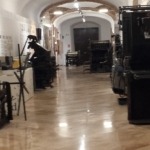 Inaugurated in 1987. Remodelled and reopenend in 2008.
Inaugurated in 1987. Remodelled and reopenend in 2008.
Museum für Gestaltung Zürich (Zürich design museum, Zürich, Switzerland)
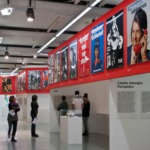 The origins of the collections of the Museum für Gestaltung (originally known as the Kunstgewerbemuseum) go back to 1875 when it was started in order to provide examples of best practice for teaching purposes. By 1933 the collection contained some 4,000 posters; by 1953 it had grown to 20,000; and in 1955 it almost doubled in size with the acquisition of the private collection of Fred Schneckenburger which comprised some 15,000 posters of all sorts: artistic and vernacular, commercial and cultural, political and social, etc., an eclecticism which provoked a certain amount of criticism from traditionalists for whom only artistic posters were worthy of serious consideration.
The origins of the collections of the Museum für Gestaltung (originally known as the Kunstgewerbemuseum) go back to 1875 when it was started in order to provide examples of best practice for teaching purposes. By 1933 the collection contained some 4,000 posters; by 1953 it had grown to 20,000; and in 1955 it almost doubled in size with the acquisition of the private collection of Fred Schneckenburger which comprised some 15,000 posters of all sorts: artistic and vernacular, commercial and cultural, political and social, etc., an eclecticism which provoked a certain amount of criticism from traditionalists for whom only artistic posters were worthy of serious consideration.
Its collections now include over 350,000 political, commercial and cultural posters (Swiss and international) since the mid-nineteenth century of which 120,000 have been researched and documented.
In 1959 the Museum für Gestaltung Zürich (as it was by then known) organised an important exhibition of posters entitled Meister des Plakatkunst (Masters of poster design). The posters exhibited were all taken from its own collections. Many were Swiss but the exhibition also included classic French illustrated posters of the late nineteenth century and Russian constructivist designs. In doing so it contributed to both the dissemination of modernist designs and the construction of the canon of contemporary Swiss design which has had such an important influence internationally up until the present day.The Museum opened an exhibition space dedicated to graphic design in 1987. Today it is part of the Cultural Studies Department at the Zürcher Hochschule der Künste (formerly known as the Kunstgewerbeschule Zürich). The stated aim of the collection is to consider posters not simply as formal graphic or artistic objects but also as historical, cultural and social documents and sources.
1988
Letterpress Printing Museum (Pinaroo, Australia)
Part of the Mallee Tourist and Heritage Centre.
Musée du papier Le Nil (Angoulème, France)
The origins of the paper mill in which the Musée du Papier is housed go back to the French Revolution. In 1819 the site was acquired by Jean Lacroix whose family exploited it for a century, before it became the Joseph Bardou ‘Le Nil’ paper mill famous for its cigarette papers. Le Nil closed in 1972. Renovated in 1983, the museum buildings form a bridge, over the river between the rue de Bordeaux and the island of Saint-Cybard. The ground floor rooms house an interpretation centre devoted to the crafts and industry linked to the river. Upstairs, temporary exhibitions present the Musée’s various collections.
Drukkunstmuseum: historische drukkerij & grafisch atelier (Maastricht, Netherlands)
Originally set up as the Museum de historische drukkerij (it changed name in 2014), the Drukkunstmuseum was based on the printmaking workshop of the artist René Glaser who founded the museum. Initially created as a printing museum it has more recently changed identity to become a museum of the art of printing. The Museum belongs to the Stichting Drukkerij Museum (Printing Museum Foundation).
Scryption (Tilburg, Netherlands)
Scryption was a museum of written communication. It opened its doors in 1988, and was based on the collection of typewriters and other writing instruments that Brother Ferrerius van den Berg had built up between 1950 and 1988. From 1988 to 2011 the museum was housed in a former technical school where itd a exhibition space, a repair workshop and a large depot. It regularly organised thematic exhibitions some of which were in co-production with Crypto Museum (specialised in historical cipher machines). Despite the efforts of the Scryption staff and interest on the part of visitors the Tilburg City Council took the decision to close the museum as part of financial cuts in 2010 and the musem ceased operation in January 2011. The museum’s collection has been largely dispersed, though a small part of it is still held by the Stichting Onterfd Goed foundation.
The international printing museum (Carson, California, United States)
1989
Sandkrug printing museum (Oldenberg, Germany)
Initially established with printing equipment from the defunct Drewes and Bührmann printing firms.
Musée de la bande dessinée (Angoulême, France)
The museum came into being in 1989, when the Centre national de la bande dessinée et de l’image (now the Cité internationale de la bande dessinée et de l’image) was set up and the collection of original plates from the Musée de beaux-arts d’Angoulême was donated. Since 2009, it has been housed in new, larger premises that are better suited to its various functions.
The Hall of Awa Japanese Handmade Paper (Tokushima, Japan)
A private museum dedicated to the preservation of the techniques and skills of Awa washi papermaking.
1990
Goupil museum (Bordeaux, France)
Le musée Goupil opened in Bordeaux in 1990 in what had once been the premises of a distillery and was recognised the following year by the French Ministry of culture. In 1998 however, it became part of the Musée d’Aquitaine (Bordeaux), losing its permanent display in the process. Since then the collections have been open to students and researchers by appointment only but have been used to organise several temporary exhibitions each year, a practice which is perfectly adapted to the display of fragile documents, though the resulting limited access to the copper plates and lithographic stones is no doubt regretted if only by printing historians.
The firm of Goupil & Cie was owned by a dynasty of international art publishers, active from 1827 to 1920. Operating under various names it was extremely well-known for its printed reproductions of works of art. Between 1841 and 1866, it set up branches in London, New York, Berlin, The Hague, Vienna and Brussels, and sales counters around the world. When the firm went into liquidation, its archives were bought by the Bordeaux art dealer Vincent Imberti. The collection is of considerable importance for the history of the development of photomechanical processes and the industrialisation of the production and marketing of popular images. It is composed of some 70,000 photographs, 46,000 prints, 7,200 copper plates, lithographic stones, photomechnical relief blocks for both single and multicolour work, glass photographic plates, books and journals of the time and company archives. The descendants of Vincent Imberti bequeathed the collection to the City of Bordeaux who opened the Musée Goupil in 1990.
Today, the collection can be consulted online. For more information see: https://musee-goupil.opacweb.fr/en/history-of-a-firm-and-a-museum.
Musée de l’imprimerie (Epernay, France)
Set up on the premises of the Champagne de Castellane firm along with a museum of Champagne labels. The Musée’s collection of some twenty or so late 19th and earl 20th century printing presses was put up for sale in 2023 on the occasion of the sale of the firm’s premises.
Leopold-Hoesch-Museum – Papiermuseum Düren (Düren, Germany)
The Papiermuseum Düren merged with the Leopold-Hoesch-Museum in 2009.
Samseong Museum of Publishing (Seoul, South Korea)
Set up by the Samsoeng Publishing Corporation, it devotes a significant part of its display to printing techniques and their development: woodblocks, old and rare books, movable type and printers’ tools. It also organises temporary exhibitions on Korea’s publishing and print history.
Grafiska museet Helsingborg (Helsingborg printing museum, Helsingborg, Sweden)
Robert Smail’s printing works (Innerleithen, United Kingdom)
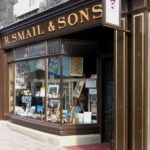 In 1986, the National Trust for Scotland bought the Smail printing works in Innerleithen when the last member of the family retired. The firm had been established in 1866. Innerleithen being a small town in the rolling countryside south of Edinburgh, Smails was a small all-purpose family printing firm which did jobbing printing, published and printed the local weekly newspaper – St Ronan’s Standard and Effective Advertiser – and sold stationery and even fishing tackle on occasion. Over a century and a quarter of activity, it had used all the principal printing processes including intaglio and lithography, but letterpress printing was its stock in trade. The museum today is the printing works as it might have been any time since about 1900 and visitors have the feeling that the last Mr Smail may have just stepped across the road to get himself a cup of tea and will be back in a moment. The type and the machines are all squeezed into the modest premises as they were in most small printshops and the office is ‘furnished’ with the firm’s everyday documentation and archives. A veritable ‘time capsule’. (Bulletin of the Printing Historical Society, n° 28, Autumn 1990, p. 12.)
In 1986, the National Trust for Scotland bought the Smail printing works in Innerleithen when the last member of the family retired. The firm had been established in 1866. Innerleithen being a small town in the rolling countryside south of Edinburgh, Smails was a small all-purpose family printing firm which did jobbing printing, published and printed the local weekly newspaper – St Ronan’s Standard and Effective Advertiser – and sold stationery and even fishing tackle on occasion. Over a century and a quarter of activity, it had used all the principal printing processes including intaglio and lithography, but letterpress printing was its stock in trade. The museum today is the printing works as it might have been any time since about 1900 and visitors have the feeling that the last Mr Smail may have just stepped across the road to get himself a cup of tea and will be back in a moment. The type and the machines are all squeezed into the modest premises as they were in most small printshops and the office is ‘furnished’ with the firm’s everyday documentation and archives. A veritable ‘time capsule’. (Bulletin of the Printing Historical Society, n° 28, Autumn 1990, p. 12.)
1991
Musée départemental du cartonnage et de l’imprimerie (Valréas, France)
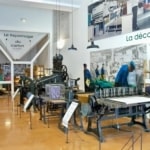 View photo gallery. This departmental museum traces the history of the manufacturing and printing of cardboard boxes in Valréas, the capital of French cartonnage industry from its origins in mid-19th century to recent times. Its extensive collections include boxes for perfumery, pharmacy, jewellery, confectionery as well as a reconstitution of a lithographic printing workshop, box-making machines, archives and collections of printed labels, posters and advertising calendars, representatives’ cards.
View photo gallery. This departmental museum traces the history of the manufacturing and printing of cardboard boxes in Valréas, the capital of French cartonnage industry from its origins in mid-19th century to recent times. Its extensive collections include boxes for perfumery, pharmacy, jewellery, confectionery as well as a reconstitution of a lithographic printing workshop, box-making machines, archives and collections of printed labels, posters and advertising calendars, representatives’ cards.
Museum Otto Schäfer (Schweinfurt, Germany)
Europäisches Zeitungsmuseum (Krefeld, Germany)
The Europäisches Zeitungsmuseum (European newspaper museum) was founded by Hans-Ulrich Nieter. It closed in 2017 because Nieter was by that time 86 years old had not found a successor for the Museum or a buyer for the collection. He did, however, have the long-awaited joy of finally seeing his collection, consisting mainly of German and European newspapers and other documents from the 17th to the 20th centuries, join the Deutsche Nationalbibliothek in Leipzig.
Graphic Museum Groningen (Groningen, Netherlands)
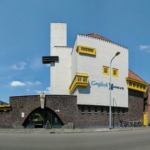 The original Graphic Museum Groningen emerged from the Groninger Association for the Preservation of Graphic Machinery whose aim was to preserve printing equipment and craftsmanship that were in danger of being lost as a result of technical developments in the printing industry in the 1950s and 1960s. All kinds of printing machines were stored on various sites in and around the city of Groningen.
The original Graphic Museum Groningen emerged from the Groninger Association for the Preservation of Graphic Machinery whose aim was to preserve printing equipment and craftsmanship that were in danger of being lost as a result of technical developments in the printing industry in the 1950s and 1960s. All kinds of printing machines were stored on various sites in and around the city of Groningen.
In 1983, a group of interested parties decided to convert the association into a foundation, with the aim of establishing and maintaining a graphics museum. The municipality of Groningen made the former 1929 Rabenhauptschool on Rabenhauptstraat available for this purpose. The building was bought from the municipality in 1989 for the symbolic price of one guilder. Subsequently, both the interior and exterior of the building were refurbished and The Graphic Museum officially opened in January 1991.
In 1993, the attic of the old building was converted into the Werkman studio, where the creation of the self-devised techniques of Groningen graphic artist Hendrik Werkman (1882-1945) are demonstrated using examples with original material. Several locally produced reproductions of his ‘druksels’ (as he called them) were on display in the room. Courses in Werkman techniques were also held there.
In November 2012, the museum changed its name to GR-ID: Museum for Realising Graphic Ideas, where the letters stand for GRafic IDeeën and GRoninger IDentiteit. This was done as part of a plan to ‘realise an entirely renewed museum in the next two years which would focus on themes such as letter and image and where experimentation, activity and innovation prevail.’ Three years later, it was decided to move this renewed museum to the Groningen city centre, next to the Martini Church. The name of the museum was changed again, to GRID Grafisch Museum Groningen in the hope of increasing the number of visitors from around 4-5,000 per year on Rabenhauptstraat to three times that in the centre of Groningen. The move was partly prompted by a declining number of visitors. In 2011, for example, 7,000 people still visited the museum, but since the move, the museum was attracting 1,000 visitors a month. (Source: Wikipedia)
Norsk grafisk museum (Norwegian Printing Museum, Stavanger, Norway)
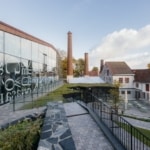 View photo gallery. Founded in 1991 it welcomed the public to its first exhibitions two years later in an old cannery warehouse in Sandvigå in Stavanger. The building and its neighbourhood were later re-zoned for hotel construction and in 2013 the museum closed and the collection was put into storage, in anticipation of new premises which were duly inaugurated in the Spring of 2021. The Norwegian Printing Museum now shares a site with the Norsk hermetikkmuseum (Norwegian Canning Museum), founded in 1982, under the joint name IDDIS, the local Stavanger term for labels. The two museums share a common industrial history, as it was the need for colorful labels and packaging for the growing canning industry that laid the foundation for the strong graphic industry in Stavanger.
View photo gallery. Founded in 1991 it welcomed the public to its first exhibitions two years later in an old cannery warehouse in Sandvigå in Stavanger. The building and its neighbourhood were later re-zoned for hotel construction and in 2013 the museum closed and the collection was put into storage, in anticipation of new premises which were duly inaugurated in the Spring of 2021. The Norwegian Printing Museum now shares a site with the Norsk hermetikkmuseum (Norwegian Canning Museum), founded in 1982, under the joint name IDDIS, the local Stavanger term for labels. The two museums share a common industrial history, as it was the need for colorful labels and packaging for the growing canning industry that laid the foundation for the strong graphic industry in Stavanger.
1992
Schrift- & Heimatmuseum Bartlhaus (Pettenbach, Austria)
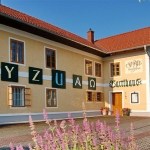 Local heritage museum with a significant section dedicated to calligraphy and bookplate art.
Local heritage museum with a significant section dedicated to calligraphy and bookplate art.
Druckgrafische Museum Weimar (Weimar, Germany)
Museum für Papier und Buchkunst (Lenningen, Germany)
Donated to the municipality by the Papierfabrik Scheufelen to commemorate the hundredth anniversary of the installation in Lenningen of the first paper coating machine in Europe.
Aiap Gallery (Milan, Italy)
Gallery established by the Aiap (the Associazione italiana design della communacazione visiva) which was itself founded in 1945 to promote Italian graphic design and the design profession. The Gallery was a precursor in the field.
The Early Printing museum (Cheongju City, Republic of Korea)
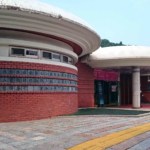 View photo gallery. The Early Printing Museum in the City of Cheonju it gives prominence to the very earliest techniques of typecasting and to Korean books, especially to the celebrated Jikji – the first known dated book to printed from moveable metal type seventy years before Gutenberg’s Bible – which is the Museum’s raison d’être.
View photo gallery. The Early Printing Museum in the City of Cheonju it gives prominence to the very earliest techniques of typecasting and to Korean books, especially to the celebrated Jikji – the first known dated book to printed from moveable metal type seventy years before Gutenberg’s Bible – which is the Museum’s raison d’être.
The Type archive, London (United Kingdom)
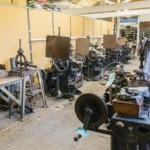 The Type Archive (formerly the Type Museum) was a collection of artefacts representing the legacy of type founding in England, whose famous type foundries and composing systems supplied the world with type in over 300 languages. The Archive was founded in 1992 by Susan Shaw in Stockwell, South London. The Archive announced in mid-2022 that it would relinquish its building and return portions of its collections to other institutions. (Consult the full Wikipedia notice here.)
The Type Archive (formerly the Type Museum) was a collection of artefacts representing the legacy of type founding in England, whose famous type foundries and composing systems supplied the world with type in over 300 languages. The Archive was founded in 1992 by Susan Shaw in Stockwell, South London. The Archive announced in mid-2022 that it would relinquish its building and return portions of its collections to other institutions. (Consult the full Wikipedia notice here.)
Oxford University Press Museum (Oxford, United Kingdom)
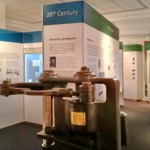 View photo gallery. In 1983, Oxford University Press stopped its letterpress operations.
View photo gallery. In 1983, Oxford University Press stopped its letterpress operations.
In 1988 a collection of printing artefacts assembled by the acting Archivist Celia Clothier was opened to the public. It was closed in June 1990 in anticipation of the creation of a fully-fledged museum in the wake of the closure of the University’s historic printing facility. When the printing office was duly closed some type was retained for the new printing museum while some three tons of type, including some dating from the late seventeenth century, went to the St Bride Printing Library.
The present Oxford University Press Museum (described as ‘the fifth museum in its Walton street office complex) opened in 1992 in a room on the ground floor of the Press behind the former North and South Houses under the direction of Peter Foden who had been appointed archivist two years previously. His mandate included ‘the rescue of documents and typographical relics’. In addition to the archives of the illustrious Bible and Learned Presses, and the Wolvercote paper mill, its collections include the famous types of Bishop John Fell and a large collection of intaglio copperplate engravings. The Museum was made over in 2013 (approx.)
Curiously for such a recent initiative the exact origins of the Museum are somewhat obscure. John Johnson, Printer to the University, a keen ephemerist, had installed a number of display cabinets in his offices: an arrangement that was still in place in the 1960s.
An illustration in the collections of the OUP’s archives shows a ‘printing museum’ which could be visited by appointment. The use of lower case in ‘printing museum’ would suggest that is was a more or less internal historical resource. A typewritten caption on the back of the illustration tells us that it is a ‘View of the printing museum (c. 1960s). It was situated on the first floor of the North and South houses facing the quad. The contents were moved to a new museum on the top floor of South house in 1978 but were boxed up in 1986, when the building was taken over for offices…’. (See also above: 1968.)
1993
Book art museum (Lódz, Poland)
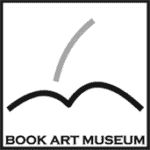 The Book Art Museum in the Polish city of Lódz was founded in 1993 and has an important collection of contemporary book art while at the same time running a very active workshop through which it maintains an important presence in the typefounding and letterpress printing community. Its historical collections include a wide range of types which were used in Poland in the nineteenth and twentieth centuries as well as an extensive range of Monotype matrices. Various projects are aimed at developing a better understanding of Polish typography and ways of interfacing traditional typecasting machines with modern digital technologies. In the quarter century since its foundation by Janusz and Jadwiga Tryzno, the Book Art Museum has been very active in creative book arts projects for which it has received many awards including the institutional award of the American Printing History Association (Apha) in 2015 for its contribution to the book arts. It has designed and published numerous bibliophile and artists editions under its imprint Correspondence des arts. The Museum is located in a villa which formerly belonged to Henryk Grohman, and important historical figure in the political and arts scenes. As an independent Museum, and despite its intense and widely recognised activity, the Book Arts Museums has for many years led a very precarious life with little institutional support, and at times significant obstruction on the part of the local authorities.
The Book Art Museum in the Polish city of Lódz was founded in 1993 and has an important collection of contemporary book art while at the same time running a very active workshop through which it maintains an important presence in the typefounding and letterpress printing community. Its historical collections include a wide range of types which were used in Poland in the nineteenth and twentieth centuries as well as an extensive range of Monotype matrices. Various projects are aimed at developing a better understanding of Polish typography and ways of interfacing traditional typecasting machines with modern digital technologies. In the quarter century since its foundation by Janusz and Jadwiga Tryzno, the Book Art Museum has been very active in creative book arts projects for which it has received many awards including the institutional award of the American Printing History Association (Apha) in 2015 for its contribution to the book arts. It has designed and published numerous bibliophile and artists editions under its imprint Correspondence des arts. The Museum is located in a villa which formerly belonged to Henryk Grohman, and important historical figure in the political and arts scenes. As an independent Museum, and despite its intense and widely recognised activity, the Book Arts Museums has for many years led a very precarious life with little institutional support, and at times significant obstruction on the part of the local authorities.
Dansk plakatmuseum (Danish poster museum, Aarhus, Denmark)
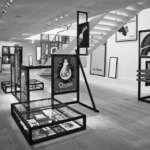 Based on the collection of a private collector, the artist Peder Stougaard, the project to create a Danish poster museum began in 1986 with the setting up of an association with this end in view. The collection was publicly funded and the posters were stored within the Åbyhøj library, where they continue to be stored to this day. In 1993 the Museum opened in an annexe of the local Art Gallery in the centre of Aarhus. In 2006, the Danish Poster Museum became part of the City’s Old Town (Den Gamle By Den Gamle an institution governed by a board with representatives from the trade union movement, the business community, the region, the municipality, the university and the Museum’s staff). Two years later, when the collection was recognised by the State, it was gifted to the Old Town. The Museum is now housed in a modern ‘white cube’ style exhibition space in a building built in 2009. Temporary exhibitions are shown on the ground floor and a general history of Danish posters on the first floor.
Based on the collection of a private collector, the artist Peder Stougaard, the project to create a Danish poster museum began in 1986 with the setting up of an association with this end in view. The collection was publicly funded and the posters were stored within the Åbyhøj library, where they continue to be stored to this day. In 1993 the Museum opened in an annexe of the local Art Gallery in the centre of Aarhus. In 2006, the Danish Poster Museum became part of the City’s Old Town (Den Gamle By Den Gamle an institution governed by a board with representatives from the trade union movement, the business community, the region, the municipality, the university and the Museum’s staff). Two years later, when the collection was recognised by the State, it was gifted to the Old Town. The Museum is now housed in a modern ‘white cube’ style exhibition space in a building built in 2009. Temporary exhibitions are shown on the ground floor and a general history of Danish posters on the first floor.
The printing house (Cockermouth, United Kingdom)
The collection began to be assembled in 1979 but it was in 1993 that it was opened to the public in a purpose-built building. The museum closed in 2009, a year after the death of its founder, David Winkworth.
Melbourne Museum of Printing (Melbourne, Victoria, Australia)
The collections originated with a typefoundry which was established in August 1977 to maintain the availability of metal types. The name change to MMOP occurred in mid-1993. After many years of financial uncertainty the Museum was closed and its collections sold off in 2020. Read more about the sale…
1994
Leipzig printing museum (Museum für Druckkunst, Leipzig, Germany)
Maison du patrimoine industriel et des arts graphiques (Geneva, Switzerland)
Les Silos – Maison du livre et de l’affiche (Chaumont, France)
Museo des periodismo y las artes graficas (Guadalajara, Mexico)
Dong-A printing museum (Printing culture exhibition hall, Ansan, near Seoul, South Korea)
A company-sponsored printing museum first opened in 1994 then reinstalled in the Dong-A Printing’s new factory in Ansan in 2004.
Espace Gutenberg (Yvonand, Switzerland)
Museum of the American Printing House for the Blind (Louisville, Kentucky, United States)
1995
Musée des imprimés en Luxembourg (Redu, Belgium)
Colophon – Maison de l’imprimeur (Grignan, France)
Moulin de la Tourne (Savoie, France)
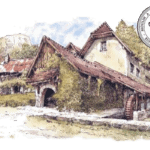 In 1987, Jacques Gaillard, a printer and publisher in Chambéry from a very old family of booksellers and printers, and a group of book-loving friends set up the association Les Compagnons du Livre with the aim of establishing a cultural and tourist site showing the evolution of writing techniques and print media over the ages. After discovering an ideal site in the Combe de Savoie, that of an old ruined 17th century mill, they decided to create the Conservatoire du Papier et des Arts Graphiques. With the help of a sponsorship committee chaired by Michel Barnier, then President of the Savoie Regional Council, a club of patrons providing the necessary capital, and with the benevolent help of Hervé Gaimard, this establishment came into being. Eight years of work were necessary before the cultural centre could be inaugurated in 1995.
In 1987, Jacques Gaillard, a printer and publisher in Chambéry from a very old family of booksellers and printers, and a group of book-loving friends set up the association Les Compagnons du Livre with the aim of establishing a cultural and tourist site showing the evolution of writing techniques and print media over the ages. After discovering an ideal site in the Combe de Savoie, that of an old ruined 17th century mill, they decided to create the Conservatoire du Papier et des Arts Graphiques. With the help of a sponsorship committee chaired by Michel Barnier, then President of the Savoie Regional Council, a club of patrons providing the necessary capital, and with the benevolent help of Hervé Gaimard, this establishment came into being. Eight years of work were necessary before the cultural centre could be inaugurated in 1995.
Center for Contemporary Graphic Art (Sukagawa, Fukushima, Japan)
Museum and archive established by Dai Nippon Printing Co., following the previous openings of ginza graphic gallery (1986) and Kyoto ddd gallery. Its aim is to pass on to future generations outstanding works and materials in graphic design and the graphic arts as valuable cultural heritage. Its two principal collections are the Tyler Graphics Archive Collection, a collection of prints representing the history of contemporary American art, and the DNP Archives of Graphic Design, a collection of major contemporary Japanese graphic design.
Centre for contemporary printmaking (Cincinnati, United States)
1996
Historische Drukkerij (Turnhout, Belgium)
China printing museum (Beijing, China)
Musée Aristide Bergès (Lorpe-Santareille, France)
Papeterie de Vaux (Vaux, France)
National print museum (Dublin, Ireland)
Museo della Carta (Pietrabuona, Pescia, Italy)
Ogaki Poster Museum (Gifu Prefecture, Japan)
The first Japanese museum devoted exclusively to posters.
Printing Museum of Cieszyn (Cieszyn, Poland)
Crandall historical printing museum (Provo, Utah, United States)
1997
Österreichische Papiermachermuseum (Laakirchen, Austria)
Hand papermaking and printing museum with temporary exhibition space on the site of a century-old papermaking factury.
Museo internacional de la gráfica (Chillán, Chile)
CNEAI – Centre national édition art image (Pantin, France)
Originally founded as the Centre national de l’estampe et de l’art imprimé.
Musée français de la carte à jouer (French playing card museum, Issy-les-Moulineaux, France)
Druck-und Satztechnik Privatmuseum Goldschagg (Munich, Germany)
Founded by newspaper publisher Rolf Goldschagg who started collecting printing machines in 1991.
The Druck- und Satztechnik Museum Goldschagg is located in one of the leafy suburbs of Munich and is unique in that it is, still, a private museum. Perhaps not that unique for Germany where more than one major historical printing museum is the work of a well to do and philanthropic businessman.
Publisher and journalist Edmund Goldschagg was editor of the Münchner Post before the Second World War. He found that his political editorials were not appreciated and so was arrested and given a Berufsverbot (Ger., forbidden to work) by the Nazis. After the war he became editor in chief and one of three publishers of the major Süddeutsche Zeitung in Munich.
His son continued in the family business as CEO of the Süddeutscher Verlag until his retirement in 1991. His staff knew of his passion for the days of letterpress and so gave him on his retirement an old platen. This became the foundation for what is today a very sizeable collection of important letterpress printing machinery.
The museum was established in 1997 and celebrated its tenth anniversary in 2007 by publishing a book on the collection. A DVD is also available. The idea behind the museum is to illustrate all aspects of letterpress. However, working in the newspaper industry, much of the emphasis is also on newspaper production. Items include not only an iron toggle hand press (Deutsche Presse by Mansfeld, ca. 1880), Linotype casters as well as a Leningrad caster (1960), a largish Koenig & Bauer newspaper cylinder press (1960) and two Heidelberg windmills (one being a Czech knock-off!) but also a Hogenforst pin perforator,
a wall of type cabinets, not only a Monotype but also a Linotype tape composition keyboard, a Monophoto 400, a router for curved newspaper plates—and others too numerous to mention. And all in finest condition although several seem to have been ‘restored’ as in repainted.
After the death of Rolf Goldschagg, his two children continued with the museum. Tours are by appointment only and about one a month. There is usually also a minimum size requirement and so I felt especially privileged not only to be given a one on one personal tour but to be driven to and from the museum by its new owner. I wonder what Martin Schall thought of this odd fish from Australia—a librarian obsessed with printing history?
The Goldschagg family had recently decided to sell the collection. Actually, the deal was finalised just four days before! I believe the Gutenberg Museum had an interest in the collection but in the end it went to another wealthy business family, the Schalls, the owners of a number of printing businesses in the field of security and specialty printing.
(Source: Jurgen Wegner: The Shadowland newsletter, n° 57, décembre 2015, Eastwood, Australia.)
Buchdruckmuseum Zschopau (Zschopau, Germany)
Officially opened in 1997, several of the machines in the collection had been exhibited since 1993 in Zschopau Castle.
Druckmuseum/Haus für Industriekultur (Darmstadt, Germany)
Museum Papiermühle Homburg (Homburg/Main, Germany)
Museo della carta di Mele (Acquasanta, Italy)
Museu nacional de imprensa (Porto, Portugal)
Jeonju Hanji Museum (Jeonju, South Korea)
Originally founded as the Hansol Paper Museum, it changed its name to Pan-Asia Paper Museum in 2001, before adopting its present name in 2005.
Newseum (Washington, United States)
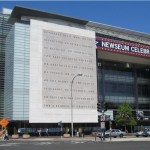 The Newseum was originally located in Rosslyn, Virginia, just outside Washington DC, until 2002 when its parent institution, the Freedom Forum, purchased a site on Pennsylvania Avene (close to the White House) where it reopened in 2008. After a successful period of activity the Nuseum was closed again in 2019 when the building was sold for financial reasons. In 2021 it was hoping to find new premises in which to reopen.
The Newseum was originally located in Rosslyn, Virginia, just outside Washington DC, until 2002 when its parent institution, the Freedom Forum, purchased a site on Pennsylvania Avene (close to the White House) where it reopened in 2008. After a successful period of activity the Nuseum was closed again in 2019 when the building was sold for financial reasons. In 2021 it was hoping to find new premises in which to reopen.
1998
Museum of printing at NERAM (Armidale, New South Wales, Australia)
The Museum of Printing at the New England Regional Art Museum (NERAM) began its life in 1998 when the NERAM received the historical collections of the F. T. Wimble printers’ supplies company. The firm had been founded in 1868 by Fred T. Wimble, son the British ink manufacturer Benjamin Wimble. It was the first enterprise of its kind in Australia and went on to be a major supplier of graphic arts equipment and supplies throughout the twentieth century.
Between 1970 and 1975 F. T. Wimble Co. came progressively under the control of Mr H. L. Wallace who began collecting historic machines related to the early history of the firm at about the same time. A company museum was set up with, as its curator, Ralph Grisdale the last employee to have worked directly with the founder of the firm. Grisdale ‘retired’ in 1984 to devote two days a week to the restauration of the machines. In 1998 the collection was offered to the New England Regional Art Museum which built a gallery space to house and display it with the help of various sponsors and government funding, thus establishing a unique regional museum of art and industry, and the only public museum in Australia devoted to printing heritage. (Source : NERAM.)
Mundaneum (Mons, Belgium)
The original Palais Mondial-Mundaneum was destroyed in 1934 at which time its collections were put into storage. After several removals the collections were installed in a former Art Deco style L’Indépendance department store in the centre of Mons in 1993. The building was renovated and the new Mundaneum was opened to the public in 1998 with an exhibition and conference space designed by François Schuiten et Benoît Peeters.
Offizin Schwarze Kunst, Buchdruckerei-Museum und Schauwerkstatt (Krakow-am-See, Germany)
British library (new building and exhibition spaces), London, United Kingdom)
Created by act of Parliament in 1973, the British library acquired the printed collections of the British museum. It’s new building, inaugurated in 1998, devoted extensive spaces to temporary and permanent exhibitions related to books and other printed material.
Crandall historical printing museum, Provo, Utah, United States.
1999
Mercury print museum (Hobart, Tasmania, Australia)
Closed to the public in 2015.
Musée de la Biscuiterie LU (Nantes, France)
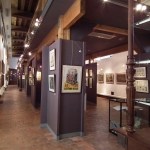 A museum dedicated to a local industry: la biscuiterie LU in Nantes which would never bill itself as a printing or graphic arts museum if only because its visitor potential resides in the the name of the prestigious and historic biscuit manufacturer. For most French people the name LU means biscuits and perhaps old illustrated metal boxes sitting on grandma’s kitchen shelves (or perhaps modern facsimile ‘reprints’ of some of the classics. For art historians and poster collectors the name LU would evoke Alfons Mucha (1860-1939) the painter and designer whose Art nouveau designs contributed so much to the success of the LU biscuit brand and indelibly marked graphic design at the turn of the twentieth century.
A museum dedicated to a local industry: la biscuiterie LU in Nantes which would never bill itself as a printing or graphic arts museum if only because its visitor potential resides in the the name of the prestigious and historic biscuit manufacturer. For most French people the name LU means biscuits and perhaps old illustrated metal boxes sitting on grandma’s kitchen shelves (or perhaps modern facsimile ‘reprints’ of some of the classics. For art historians and poster collectors the name LU would evoke Alfons Mucha (1860-1939) the painter and designer whose Art nouveau designs contributed so much to the success of the LU biscuit brand and indelibly marked graphic design at the turn of the twentieth century.
At the end of the 190os the Danone group was looking for a permanent location where it could exhibit its considerable collection of artistic and graphic material related to the LU brand. And for 20 years is was housed in 400 m2 in the former stables of the Château de Goulaine near Nantes, supported by a 60,000 euros per year subsidy by the firm. The Museum was the guardian of an extraordinary collection of the firm’s graphic design, much of it signed by Mucha — 600-odd items, from original drawings and paintings through posters and cardboard packaging to point of sale materials and decorated metal boxes.
In 2007 Danone sold the LU brand to Mondelez which decided in 2018 to cease its support for the Museum which closed at the end of 2019.
It would of course be improper to describe this museum as a printing museum, even if most printing museums would give their eye teeth to possess such a collection. But printing and graphic heritage it certainly was.
Papiermuseum Alte Dombach (Alte Dombach, Germany)
In December 1987, the papermakers Zanders Feinpapiere AG and J.W. Zanders AG transferred the buildings and properties of the Alte Dombach to the Landschaftsverband Rheinland for incorporation into the LVR Industrial Museum. Opened in 1999, the museum covers the history of paper production and paper use from around 1750 to the present day.
Hamilton Wood Type & Printing Museum (Two Rivers, Wisconsin, United States)
2000
Japan Newspaper Museum (Newspark, Yokohama, Japan)
Founded by the Nihon Shimbum Kyokai (NSK), the Japanese Newspaper Publishers & Editors Association.
Print and playing card museum of Luxembourg (Kulturhuef) / Musée luxembourgeois de l’imprimerie et de la carte à jouer / Luxemburger Druck- und Spielkartenmuseum (Grevenmacher, Luxembourg)
Ivan Fedorov Museum (Moscow, Russia)
The Museum of the History of Printing, Book Publishing and Moscow State University of Printing and Publishing, named after Ivan Fedorov, the first known Russian printer in Moscow and the Polish–Lithuanian Commonwealth.
Encre & plomb. Atelier-musée de l’imprimerie (Chavannes-près-Renens, Switzerland)
Musée suisse des arts graphiques et de la communication (Fribourg, Switzerland)
In 1991 it was decided to move the Gutenberg Museum in Berne (see 1900), which had been closed since 1985, to Fribourg where it reopened in the year 2000 in a beautifully but expensively restored historic building in the centre of the town as the Gutenberg Museum – Musée suisse des Arts graphiques et de la Communication. Unfortunately, the frequentation of the Museum was not sufficient to meet its running costs and three years later, in January 2003, heavily in debt, it was obliged to close. A year later it declared itself bankrupt. In June 2005, the Swiss print employers’ organisation Viscom (Société suisse pour la communication visuelle) undertook to buy the building for 2,3 million swiss francs and the Museum opened again at the end of the same year. The Museum is currently run jointly by Viscom, as owner of the building, and the Friend of the Museum as owner of the collections. (https://www.rtn.ch/rtn/actualite/nationale/000fribourg_le_musee_gutenberg_a_rouvert_ses_portes_apres_deux_ans_1.html)
Frogmore Paper Mill (Hemel Hempstead, United Kingdom)
In 2000 the Apsley Paper Trail charity was formed to conserve this unique historical site and make it accessible to the public.
The Grabhorn Institute (San Francisco, United States)
The Grabhorn Institute is a nonprofit organization formed in October 2000 for the purpose of preserving and continuing the operation of one of the last integrated facilities for typefounding, letterpress printing, and bookbinding in the fine press tradition, as a living museum and educational and cultural center. It is named in honor of the brothers Edwin and Robert Grabhorn, who established the Grabhorn Press in San Francisco in 1920. The press was ‘one of the foremost producers of finely printed books in twentieth-century America.’ The Grabhorn Press Building is listed on the National Register of Historic Places in San Francisco, California. (Wikipedia)
2001
Penrith Printing Museum (Penrith, New South Wales, Australia)
Read more about Penrith Printing Museum.
Päivälehti Museum (Helsinki, Finland)
Dedicated to the history of newspapers and the media, contemporary media and freedom of speech in Finland and elsewhere.
Museum für Druckgeschichte (Weilerswist, Germany)
Plöger paper mill (Schieder-Schwalenberg, Germany)
Druckereimuseum (Benary-Speicher Museum, Erfurt, Germany)
Based on the collection put together since 1981 by employees of the local printing firm of Fortschritt.
Buchdruckerei-Museum (Burkhardtsdorf, Germany)
Installed in the premises of the local Schreiber printing which closed in 1992.
Museo Civico della Stampa Mondovì (Mondovì, Italy)
Museum Graphia – Museo Internazionale della Stampa (Urbino, Italy)
Nederlands steendrukmuseum (Valkenswaard, Netherlands)
View photo grallery.
2002
Miniatür Kitab Muzeyi (Museum of miniature books, Baku, Azerbaijan)
Propaganda Poster Art Centre (Shanghai, China)
Offers a view of changes in modern China as seen through posters. It founder, Yang Pei Ming, started collecting posters in 1995 after propaganda materials were deleted by official government organisations for political reasons.
Tipoteca italiana (Cornuda, Italy)
View photo gallery. The Tipoteca Italiana Fondazione was officially established on the 21st June 1995. The Tipoteca Italiana Type and Printing Museum opened its doors seven years later in 2002.
The Tipoteca possesses an exceptional collection covering all aspects of nineteenth and twentieth century Italian typography: metal and wood type, typefounding and typesetting equipment, printing presses, finishing equipment, type specimens and documentation.
The Museum is extensive: consisting originally of a series of large exhibition rooms, workshops and reserves ranging over two floors, it has since built a brand new two-floor annexe across the road, next to the Brentella canal, with a restaurant and auditorium. The exhibition galleries take the visitor from the recreation of a traditional printing workshop with its case racks and hand presses, through the manufacture of both metal and wood type and industrial printing presses, into the aesthetics of letterforms with many fine examples of the work of Italian foundries and type designers. Like most museums the Tipoteca exhibits only a fraction of its collections of machines, ancillary equipment and archives, the collection and restoration of which is an active, ongoing (and probably endless) project. By the end of its first ten years in existence the Tipoteca had collected over one hundred and fifty machines of all sorts: typesetting machines, presses and binding and finishing equipment. Notable among the Tipoteca’s collections are the archives of the post-war Italian type designer Aldo Novarese (1920-1995) and those of the Melchiori wood type manufacturer). The Tipoteca also regularly invites typographers and designers to use the Museum’s type collections as part of a very active editorial programme.
The Tipoteca is housed partly in a late 19h century industrial building (1882) which was once the Canapificio Veneto Antonini-Ceresa, once an important rope maker, and partly in the Santa Theresa church which was built around the same time (1886). The part of the building which houses the Tipoteca’s reserves was built in the early 20th century (post 1908). The rope works flourished until the Second World War, after which it went into decline bfore closing down in 1967. The buildings were remodelled for the Tipoteca by the architects Roberto Pescarollo, Jordi Ferrando i Arrufat and Giuseppe Cinel and the building work supervised by a long-time collaborator of the Museum, Alberto Prandi.
The moving force of the Tipoteca, Silvia Antiga, has been (and remains) a practising printer since 1960 with a flourishing printing business which he runs with his sister and three brothers. His professional activities, in combination with his passion for all aspects of Italian typography, gave him access to the world of traditional printing throughout Italy, which he has been exploring extensively for nearly half a century.
Read more about the Tipoteca : The Tipoteca Italiana: ‘we have a great future behind us!’
Buchdruck-Museum Hannover (Hanover, Germany)
Anokhi Hand Printing Museum (Amber, Jaipur, India)
2003
Musée de l’image (Museum of the image, Épinal, France)
View photo gallery.
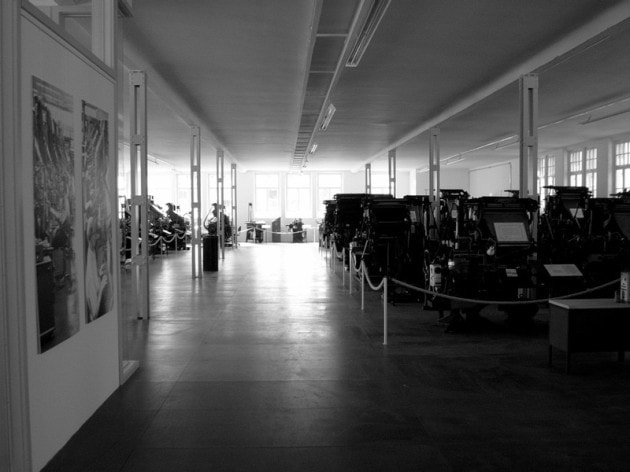 Technikmuseum Im Manz-Bau (Linotype museum, Schopfheim, Germany)
Technikmuseum Im Manz-Bau (Linotype museum, Schopfheim, Germany)
On 31 May 2003, thanks to private commitment, the museum of technology opened in the Manz building on the former site of the shoe factory in Fahrnau. The museum was open during the summer months and offered the opportunity to view a comprehensive collection of Linotype typesetting machines and tools from the printing industry. Unfortunately, the Museum had to vacate the previous premises, with the resuklt that it was forced to close in October 2017. A large part of the collection found a new home in the Gutenberg Museum in Mainz.
Archivio museo della stampa (Genoa, Italy)
Stichting Grafisch Erfgoed (Graphic heritage foundation, Orvette, Netherlands)
Ceased activity in 2014.
Woodblock Print Museum (Sillim-myoen, South Korea)
View photo gallery.
Bodmer museum (Cologny, Switzerland)
2004
Museum für Druckgrafik (Rankweil, Austria)
Die Druckwerkstatt Mosbach (Mosbach, Germany)
Collection was brought together by the Druckwerkstatt e.V. support and fundraising organization which was set up in 1994 and displayed as a department of the Mosbach City Museum (Stadtmuseum) since 2004.
Papiermuseum Fockendorf (Fockendorf, Germany)
Deutsches Zeitungsmuseum (German newspaper museum, Wadgassen, Germany)
View photo gallery. The museum collection exceeds ten thousand items covering objects, the library and archival material including highlights such as the 1632 broadsheet showing a view of a newspaper printing and production room. It is based on the donation of two large special collections. One is the collection of the newspaper historian Dr Martin Welke who has his own private museum at Meersburg on Lake Constance. The other, the former collection of the Zentrum für Druck- und Buchkultur (Centre for Print and Book Culture).
Muzeum Piśmiennictwa i Drukarstwa w Grębocin (Paper and Printing Museum of Grębocin, Grębocin, Polish People’s Republic)
IMOGA Istanbul museum of graphic arts (Istanbul grafik sanatlar müzesi, Istanbul, Turkey)
IMOGA, Istanbul Museum of Graphic Arts (Istanbul Grafik Sanatlar Müzesi), claims to be Turkey’s only printmaking museum. Founded in 2004 by the teacher-printmaker Süleyman Saim Tekcan, it is housed in two floors of a purpose-built 2,000 m2 building which it shares with Tekcan’s Artess Printmaking Studio and that of the sculptor Ali Teoman Germaner. The top floor of this four-storey building is used for various events. The ground and basement floors (1,100 m2) which the Museum occupies provide exhibition space for its collections. Administration is on the top floor and flats offer accommodation for visiting artists.
The IMOGA is thus closely linked to Tekacan’s own printmaking activity which he has been pursuing since he set up his first studio in 1974 and which was open to other artists. (It is claimed that this was the ‘first professional printmaking studio’.) The studio relocated in 1984 to larger premises in Çamlica, adopting the name Artess Printmaking Studio.
According to the IMOGA catalogue, printmaking was established in Turkey by Leopold Levy, a Parisian who, as head of the painting department of the Mektep-i Sanayi-i Nefise school of fine arts, created the first printmaking studio in the country, where he trained and encouraged many Turkish artists. Printmaking became more widespread in the second half of the twentieth century.
2005
Museum of typography (Chania, Crete, Greece)
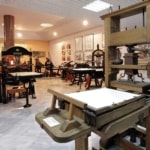 View photo gallery. The Museum of Typography, located on a light industrial estate on the outskirts of the town of Chania in the north-west of the island of Crete, first opened to the public in 2005. It was set up by Yiannis and Eleni Garadakis with the aim of ‘leaving a legacy to their home town that connects the history of printing to the present and – hopefully – to the future of printed matter’. The Museum was conceived of as a means both of preserving and maintaining historical printing machines and techniques, and honouring the memory of those who had spent their lives in the printing trade. Yiannis had been a co-founder of the Haniotika nea (Chania News) in 1967, a local newspaper of which he is still the proprietor, and, over the years, had built up a collection of nineteenth and twentieth century printing equipment ranging from metal hand presses, Linotype and Monotype hot metal composing machines to a section of the firm’s rotary offset press when it came to be renewed. The range of historical printing equipment available in Crete being limited, the majority of the machines which he acquired came from abroad, notably from the Netherlands, Germany and Switzerland. Once opened the Museum received donations from all over Greece of rare books, newspapers and prints.
View photo gallery. The Museum of Typography, located on a light industrial estate on the outskirts of the town of Chania in the north-west of the island of Crete, first opened to the public in 2005. It was set up by Yiannis and Eleni Garadakis with the aim of ‘leaving a legacy to their home town that connects the history of printing to the present and – hopefully – to the future of printed matter’. The Museum was conceived of as a means both of preserving and maintaining historical printing machines and techniques, and honouring the memory of those who had spent their lives in the printing trade. Yiannis had been a co-founder of the Haniotika nea (Chania News) in 1967, a local newspaper of which he is still the proprietor, and, over the years, had built up a collection of nineteenth and twentieth century printing equipment ranging from metal hand presses, Linotype and Monotype hot metal composing machines to a section of the firm’s rotary offset press when it came to be renewed. The range of historical printing equipment available in Crete being limited, the majority of the machines which he acquired came from abroad, notably from the Netherlands, Germany and Switzerland. Once opened the Museum received donations from all over Greece of rare books, newspapers and prints.
Originally installed in premises next to the Haniotika nea’s production facility, the Museum was enlarged in 2012 when it took over the building which had, until 2009, housed the paper’s rotary press. The new wing was designed to keep its industrial aspect while offering visitors displays relating to the development of the graphic arts in general. A further extension was inaugurated in 2015 on the occasion of the donation of an important archive by the collector Kostas Tzortzakis which included sixteenth and seventeenth century Venetian editions and prints.
(Yiannis Garedakis, ‘The Museum of Typography in Greece’, Gutenberg Jahrbuch 2016, Mainz, 2016.)
Litografiska Museet (Lithography museum, Sundby Gård, Huddinge, Sweden)
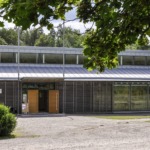 The Litografiska Museet, located at Sundby Gård, a recreation area owned by the town of Huddinge, south of Stockholm, is based on the collections of a society of lithographic artists founded in 1929. The Litografklubben brought together artistic lithographers who, as well as distributing their prints among its members, also built up a collection of their works. In 1994 a foundation was set up – the Litografklubbens Arkiv – to preserve the collection of prints, to which was gradually added various lithographic machines, stones and tools. This led in due course to the creation of a museum which opened its doors in 2005 with the aim of promoting lithography, its techniques and its history.
The Litografiska Museet, located at Sundby Gård, a recreation area owned by the town of Huddinge, south of Stockholm, is based on the collections of a society of lithographic artists founded in 1929. The Litografklubben brought together artistic lithographers who, as well as distributing their prints among its members, also built up a collection of their works. In 1994 a foundation was set up – the Litografklubbens Arkiv – to preserve the collection of prints, to which was gradually added various lithographic machines, stones and tools. This led in due course to the creation of a museum which opened its doors in 2005 with the aim of promoting lithography, its techniques and its history.
Today, the Litografiska Museet is a combined museum and workshop whose aim is to preserve the art and techniques of lithography through workshops, educational activities, exhibitions and visiting lithographers. Its printed collections include art works, posters, labels, letterheads and packaging from the 19th and 20th centuries. It also has printing machines and ancillary equipment, and around 1,000 lithographic stones, most of them with images on them. A large part of the printed collections has been digitized.
m.a.x. museo (Chiasso, Italy)
Museum founded by Aoi Huber Kono to celebrate the work of her late husband, the Swiss graphic designer Max Huber (1919-1992) and her father the Japanese graphic designer Takashi Kono. Its mission is to promote graphic design, photography and art.
2006
Musée de l’imprimerie du Québec (Montréal, Canada)
Le Petit musée de l’impression fut créé en 2006. Il adopta son nom actuel en 2012.
2007
Moravské kartografické centrum (Moravian Cartography Centre, Velké Opatovice, Czech Republic)
Cartography museum.
Museo della stampa Remondini (Bassano del Grappa, Italy)
Izba Drukarstwa (Lublin, Poland)
Originally established in 1973, then closed, the museum reopened in 2007 with a new theatre centre. The building was renovated and a permanent exhibition installed.
2008
Guanlan Printmaking Museum (Shenzhen, China)
Part of the vast China Guanlan Original Printmaking Base.
Museo della stampa e stampa d’arte ‘Andrea Schiavi’ (Lodi, Italy)
MOTI Museum of the image (Breda, Netherlands)
Officially adopted this name in 2011. On 1 January 2017, MOTI merged with Breda’s Museum to become Stedelijk Museum Breda.
Casa de la Primera Imprenta de América (House of the first print shop in the Americas, Mexico City, Mexico)
Now the Continuing Education Center of the Universidad Autónoma Metropolitana, it houses the Museum of the book.
Newseum (Washington D.C., United States)
Originally located in Arlington, Virginia from 1997 (cf.) until 2002, the Newseum reopened in new premises in Washington D.C. and has since closed.
2010
Bibliotheca Wittockiana (Brussels, Belgium)
Originally a private collection centred on the book arts and bookbinding, the Bibliotheca Wittockiana opened to the public in 1983. It acquired official museum status in 2010.
TYPA (Tartu, Estonia)
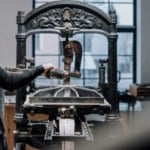 View photo gallery. Founded in the spring of 2010 as a private museum to fill the gap within memory institutions in Estonia and save the country’s last surviving letterpress machines and equipment. Since its establishment, its aim has been to work as a functioning museum and visitor centre. In 2020, it was awarded the ILUCIDARE Special Prize — part of the European Heritage Awards / Europa Nostra Awards, a major European honour in the field of cultural heritage — for its distinctive solution to preserving cultural heritage.
View photo gallery. Founded in the spring of 2010 as a private museum to fill the gap within memory institutions in Estonia and save the country’s last surviving letterpress machines and equipment. Since its establishment, its aim has been to work as a functioning museum and visitor centre. In 2020, it was awarded the ILUCIDARE Special Prize — part of the European Heritage Awards / Europa Nostra Awards, a major European honour in the field of cultural heritage — for its distinctive solution to preserving cultural heritage.
Maison de la typographie (Haspres, France)
Museo della stampa ‘Città di Lecce’ (Merine, Lecce, Italy)
Museo del Libro Fadrique de Baslea (Burgos, Spain)
2011
Musée de l’imprimerie de Limoux (Limoux, France)
L’idée de préserver le patrimoine culturel et transmettre le savoir-faire de de l’imprimerie a été impulsée par l’ancien imprimeur Jean-Claude Laffont, mais ce n’est qu’en 1996, qu’elle a pris forme. Les responsabilités diverses de Jean-Claude Laffont, dont celle d’administrateur national du Fonds social de la Caisse de retraite complémentaire de l’Imprimerie, en charge des régions du Poitou-Charente, du Limousin, de l’Auvergne, de Midi-Pyrénées (Aveyron-Tarn) et du Languedoc-Roussillon (Lozère), lui ont permis de rencontrer de nombreux imprimeurs et de construire, grâce à leurs dons, une importante collection. Il a regroupé autour de lui des imprimeurs actifs et retraités, auxquels sont venues s’ajouter des personnes qualifiées qui, en avril 1998, fondèrent «l’Association du musée des arts graphiques et de la communication», avec comme objectif de mener des activités culturelles, de créer un Musée de l’Imprimerie et de proposer des ateliers manuels pédagogiques. Après le déménagement des collections de Bozouls, à Capdenac-Gare, au Pont-Viel et à Bel-Air à Rodez, aucune solution convenable n’ayant été trouvée, l’Association des Amis du Musée de l’Imprimerie, des Arts graphiques et de la Communication a été accueillie par Jean-Paul Dupré, député-maire de la Ville de Limoux, qui a été intéressé par le projet et mis en place le Musée de l’Imprimerie. Le Musée a été inaugurée le 21 octobre 2011, partageant l’espace de l’ancien tribunal avec le Musée du Carnaval. (https://museedelimprimerie.fr/historique/)
Comana Paper Museum (Comana, Romania)
Paper mill and letterpress printing and bookbinding workshop-museum.
Museo Alzamora (Girona, Spain)
C. C. Stern Type Foundry (Oregon, United States)
 Opened as a working museum in 2011, the C.C. Stern Type Foundry has continued to acquire equipment, tools, and matrices, as well as books, artwork and ephemera from the letterpress printing and type casting community. Its collection includes (as of 2024) American Monotype composition casters and keyboards, an English composition caster, an Orphan Annie sorts caster, a Thompson sorts caster, a Material Maker strip caster, a Monotype Giant Caster, a Linotype 31, a Ludlow Typograph line caster, a Pantograph, a hand casting mould, and a Welliver computer keyboard interface for the Monotype Composition Caster. The type library consists of nearly 1,000 matrix cases, one of the largest collections of Monotype casting matrices in the United States. The techniques on display during working hours and special events offer a window into the skill and wisdom of type casting tradesmen and craftspeople from many corners of the world. The working museum is meant to be dynamic, rather than a collection of static exhibits. The active restoration and operation of its machines allows the type foundry to evolve over time, drawing volunteers and visitors to interact more deeply and directly with the elements of the Foundry as they encounter them.
Opened as a working museum in 2011, the C.C. Stern Type Foundry has continued to acquire equipment, tools, and matrices, as well as books, artwork and ephemera from the letterpress printing and type casting community. Its collection includes (as of 2024) American Monotype composition casters and keyboards, an English composition caster, an Orphan Annie sorts caster, a Thompson sorts caster, a Material Maker strip caster, a Monotype Giant Caster, a Linotype 31, a Ludlow Typograph line caster, a Pantograph, a hand casting mould, and a Welliver computer keyboard interface for the Monotype Composition Caster. The type library consists of nearly 1,000 matrix cases, one of the largest collections of Monotype casting matrices in the United States. The techniques on display during working hours and special events offer a window into the skill and wisdom of type casting tradesmen and craftspeople from many corners of the world. The working museum is meant to be dynamic, rather than a collection of static exhibits. The active restoration and operation of its machines allows the type foundry to evolve over time, drawing volunteers and visitors to interact more deeply and directly with the elements of the Foundry as they encounter them.
2012
The Museum of Printing (Yerevan, Armenia)
View photo gallery.
DruckZeug (Graz, Austria)
DruckZeug operates the former Bauer book printing works in Graz as a living museum. The aim of the association is to preserve and pass on the knowledge of the old trades: typesetting, letterpress printing and bookbinding. Naturally also in combination with contemporary design.
Conservatoire des arts et techniques graphiques (Ribeauvillé, France)
Spazio La Stampa (Turin, Italy)
House museum of La Stampa daily newspaper.
Georgia Weekly Newspaper Museum (Homer, Georgia, United States)
Privately-owned museum showing how a typical North American rural weekly newspaper was published by letterpress in the era of 1888-1940, and even into the 1960s.
2013
The Royal Press (Melaka, Malaysia)
Living metterpress museum based on the polyglot printing establishment of the same name.
Museu de imprensa Madeira (Câmara de Lobos, Madeira, Portugal)
2014
Musée Médard (Lunel, France)
View photo gallery. Consacré à l’histoire du livre et aux arts et métiers liés au patrimoine écrit, conçu autour de la collection qui a été léguée à la ville de Lunel par le bibliophile Louis Médard (1768-1841).
Hakle toilet paper museum (Düsseldorf, Germany)
Per Via – Museo Tesino delle Stampe e dell’Ambulantato (Pieve Tesino, Italy)
International Advertising & Design Database (IADDB) (The Hague, Netherlands)
Founded as a not for profit foundation in the Netherlands in 2014 in hommage to, and to carry on the work of Dr Sachs. The aim of the Foundation is to publicize as much information as possible concerning advertising and related graphic design and to ask the public to actively participate by adding images, names, dates and all other kinds of information. The database starts with but is not limited to posters. Posters are just part of a campaign that in the old days would include newspaper advertisements, poster stamps, handbills, packaging, etc. Nowadays an advertising campaign would also not be complete without commercials on radio and TV as well as on social media.
Barcelona Design Museum (Barcelona, Spain)
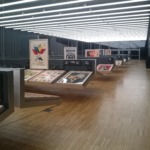 In the autumn of 2000 four museums – Museum of Decorative Arts, Ceramics Museum, Textile and Clothing museum and the Graphic Arts Museum – were administratively merged under the provisional name of the Museum of Applied Arts. The decision to create a single new museum to cover everything from decorative arts to design was taken soon after. It was encouraged by a parallel project formulated by the Art Directors & Graphic Designers Association for the Fostering of Arts and Design (ADG-FAD) under the direction of Claret Serrahima, to establish a design museum.
In the autumn of 2000 four museums – Museum of Decorative Arts, Ceramics Museum, Textile and Clothing museum and the Graphic Arts Museum – were administratively merged under the provisional name of the Museum of Applied Arts. The decision to create a single new museum to cover everything from decorative arts to design was taken soon after. It was encouraged by a parallel project formulated by the Art Directors & Graphic Designers Association for the Fostering of Arts and Design (ADG-FAD) under the direction of Claret Serrahima, to establish a design museum.
In 2007 the graphic arts collections were moved to the Palau de Pedralbes which at that time housed the Decorative arts and ceramics collections and would soon house the textile collections and renamed the Cabinet of Graphic Arts because of its relatively confidential status. At this point the project was clearly crystalizing around the idea of a design museum, with the result that the focus for the graphic arts collection became printed documents, the printing equipment being lent to other more production related cultural institutions and museums such as the Sala Themàtica d’Arts Gráphiques in Lleida and the Monastery of Santa Maria del Puig’s Museu de la Imprenta i les Arts Gràfiques near Valencia.
[In the early 2000s?] the Fundació Comunicació Gráfica was established to build a collection for a future design museum.
The Barcelona Design Museum opened its doors in 2014, housing the collections of the Museum of Decorative Arts, the Ceramics Museum, the Textile and Clothing museum and the Graphic Arts Museum. The graphic arts collections cover the period from the late nineteenth century to the present day, focusing on the development of graphic design in Catalonia. A semi-permanent exhibition is intended to offer two to three-year exhibitions on different themes, starting with the professionalisation of the graphic design profession. Acknowledging the widely established status of posters of which there are several substantial collections in the region – particularly of the Civil War period – the Design Museum pays special attention to the second half of the twentieth century, opening its collections to all sorts of printed ephemera representative of as broad a range as possible of graphic design. Less emphasis than might be expected is also given to artists who so strongly marked the lithographic illustrated poster at the turn of the century.
The Design museum was thus conceived from the start to include a dedicated exhibition space for graphic design: and rather than offering a chronological or author-based display, it chose to explore the way in which graphic design went from being an illustrated addition to the traditional advertising products produced by the printing trade to a profession in its own right. In other words it looked at how, in the course of the 1960s and 1970s, the commercial artist metamorphosed to become the graphic designer.
2015
Museu Tipografia Pão de Santo Antônio (Bairro Rio Grande, Diamantina, Brazil)
Le Moulin à papier du Liveau (Clisson, France)
2017
Magyar Papírmúzeum (Hungarian Paper Museum, Dunaújváros, Hungary)
Museo della carta (Toscolano Maderno, Italy)
2018
Atelier-Musée Imprimerie (AMI) (Malesherbes, France)
 View photo gallery. September 2o&8 saw the arrival of a major new actor on the European printing museum scene with the opening of the Atelier-Musée Imprimerie (AMI) at Malesherbes, 70 kilometres South of Paris. The AMI is the brainchild of Jean-Paul and Chantal Maury, and offers 5,000 m2 of exhibition space including workshops where visitors can make paper or learn the arts and crafts of paper marbling, type composition, printing and bookbinding. The 700 objects on display include 150 machines selected from the 300 which the Museum currently owns..Read more : First impressions of Europe’s newest printing museum.
View photo gallery. September 2o&8 saw the arrival of a major new actor on the European printing museum scene with the opening of the Atelier-Musée Imprimerie (AMI) at Malesherbes, 70 kilometres South of Paris. The AMI is the brainchild of Jean-Paul and Chantal Maury, and offers 5,000 m2 of exhibition space including workshops where visitors can make paper or learn the arts and crafts of paper marbling, type composition, printing and bookbinding. The 700 objects on display include 150 machines selected from the 300 which the Museum currently owns..Read more : First impressions of Europe’s newest printing museum.
Museum of Typography and Graphic Arts Technology (University of Ioannina, Ioannina, Greece)
View photo grallery. Ioannina is a small city with a population of about 110,000 situated in the West of the Greek mainland. As well as being the commercial centre of the region, it has a University with over 25,000 students – and a printing museum. In the seventeenth and eighteenth centuries, during the period of Ottoman rule, and before Greece had it’s own indigenous printing trade, Ioannina was an important centre for the importation and distribution of books in the Greek language produced by local merchants who had set up printing establishments in Venice. Despite the persistent wariness of the Ottoman authorities of the time, expatriate booksellers such as Nikolaos Glykys and Nikolaos Sarros (late seventeenth century) and Dimitrios Theodosiou (mid-eighteenth) produced over 1,600 editions to be distributed in Greece. So it is perhaps not altogether surprising to find a printing museum in the city of Ioannina – though it might be more accurate to say that it is a printing museum in the making, for at the moment it can only be visited by appointment. That said, however, it should be emphasized that it is really not difficult to make an appointment. (See below for contact details.)
Read more about the project : A printing museum in the making at the University of Ioannina
Museo del Libro e Officina della Stampa (Montepulciano, Italy)
Muzeum Drukarstwa w Nowym Targu (Printing museum of Nowym Targu, Nowym Targ, Poland)
Located in a new building created as part of the project Following the trail of technical monuments from Podhale to Liptov, which was implemented in 2017-2018 as part of the EU Cross-border Cooperation Programme Interreg V-A Poland-Slovakia 2014-2020 by the Municipality of Nowy Targ with partners from Slovakia, the Žilina Self-Governing Region and the Municipality of Ludrova. The Museum was inaugurated on the 12 October 2018.
2019
Le MANA Musée de l’affiche de Nantes (Nantes, France)
Musée typographique Le Rachinel (Saint-Lô, France)
Musée fondé par Fernand Le Rachinel à partir de sa collection privée de matériel d’imprimerie.
Design Museum Dedel (The Hague, Netherlands)
Dedicated to advertising and graphic design, the Museum opened while still under development. Its collections include advertising and design in the broadest sense of the word: not only posters, but also postcards, metal packaging, magazines, books, wallpaper, photos, stamps, business cards, enamel billboards, TV commercials, etc. It is located in a 17th century town house which was originally a private residence. In the early twentieth century it was acquired by an antiquarian book dealer who established his business in the building. The book business continued under verious ownerships until 2016, when it closed down.
Centro de Interpretación da Imprenta de Mondoñedo: Jesús López Díaz (Mondoñedo, Spain)
The Poster House (New York, United States)
Poster House was founded in 2015 and opened its doors to the public in 2019. Located in central Manhattan, it claims to be the first poster museum in the United States and, as such is dedicated to presenting the impact, culture, and design of posters, both as historical documents and methods of contemporary visual communication, offering temporary exhibitions, a permanent collection, and educational events.
2020
Museum of Printing at Hooton Park (Ellesmere Port, United Kingdom)
The Museum has its origins in the Juniper Press, a letterpress studio that was set up in Liverpool Bluecoat in 2014 by Ken Burnley (journeyman compositor, printing historian and educator). Juniper Press ran successfully until it outgrew the premises, and with the acquisition of the ‘Southport Columbian’ handpress, larger premises were sought. Thus it was that Juniper Press moved to Amorini Antiques Centre on the Wirral, where it opened in January 2020 as the ‘Museum of Printing at Amorini Antiques’. Due to the sale of these premises for redevelopment, space was offered at Hooton Park Hangars (Hooton Park Trust) near Chester, its present location since 2023. The Museum has a collection of handpresses, wood and metal type, and other ancillary equipment and is open to the public on Hooton Park’s Open Days, and at other times by arrangement.
2021
Museo Universitario del Grabado MUG (University Museum of Engraving, Valparaíso, Chile)
The MUG was born as a project of the Arts Fund of the Universit of Playa Ancha, a repository and archive that holds 13,357 works by Chilean artists including 9,780 prints by Latin American engravers. Funding from the Regional authorities and the University itself made it possible to acquire and restore a large house of architectural interest located in the area of Valparaíso which is a Unesco World Heritage Site (2001). The result was a modern museum with perfectly suited to the exhibition and conservation of engravings which pursues a policy of making its collection known through various media and platforms in order to reach the widest possible audience and to achieve recognition in the world of museums, especially university museums.
Музей “Книга художника” (Artists Book Museum, Moscow, Russia)
Museum of Graphic Arts Ángel Gallego Esteban-University of Alcalá (Alcalá de Henares, Madrid, Spain)
Based on the collection which the printing entrepreneur Ángel Gallego Esteban gifted to the University in 2019, and which formerly was that of the Museo didáctico de artes gráficas in the nearby town of Arganda del Rey. Born in La Horra (Burgos), Ángel Gallego arrived in Madrid in 1942 at the age of 14. There he started an apprenticeship in a printing house, first as a hand compositor and then as a linotype operator. He later went on to learn the techniques of stone lithography, page assembly and offset. During a long career in printing, first as an employee and later as an entrepreneur, he worked with many different techniques and processes. In 1958, having learned various aspects of the trade he co-founded with Germán Gutiérrez, the firm of Litografía GÁEZ de Artes Gráficas, rising from a simple workshop in Vallecas into a 12,000 m2 facility with 200 employees in Arganda del Rey. Upon his retirement in 2007, he decided to pay tribute to the graphic arts by creating a company museum for which he had already collected a wide range of objects and documents related to printing, subsequently transferred Alcalá de Henares for the University of Alcalá de Henares’ new museum.
Norwich Printing Museum (Blickling, United Kingdom)
Formerly the John Jarrold Printing Museum (Norwich) which closed in 2019. The Jarrold collections are now housed as the Norwich Printing Museum which opened in the Blickling Hall Estate in July 2021.
2024
Litho Geistel 4 (Strasbourg-Cronenbourg, France)
Announcement of a project to reopen the Geistel lithographic printing company, founded in the 1920s, as a combined museum and print workshop. Its premises, equipment and archives have remained intact since the firm ceased operations in the early 1950s, and include 5 presses, over 1,500 litho stones — of which 180 are large format — as well as the customer reception area, the clicker’s office, the overseer’s office, and the graining and finishing workshops the graining workshop. The aim of the printing works-museum is to illustrate the second printing revolution which came with the invention of lithography in 1796, and to discover the family history of an early 20th-century lithographic printer.
Annexe
Foundations date dates of some organisations working in the field of printing heritage
1901
Gutenberg Gesellschaft, Germany
1954
Wynkyn de Worde society, United Kingdom
1964
Printing historical society, United Kingdom
1971
International Senefelder Foundation, Germany
1975
The Ephemera Society, United Kingdom
1979
American printing history association, United States
1980
The Ephemera Society of America, United States
1981
Bild-Druck-Papier, Germany. In 2017 the working group ceased activity, replaced by the BildDruckPapier forum which was founded the same year.
1984
Australian Printing Historical Society, Sydney, Australia. Early pringed documents issued by the Society in 1985 indicate that it was established a year previously.
1983
Internationalen Arbeitkreises Druck- und Mediengeschichte (IADM), originally the Internationalen Arbeitkreises Druckgeschichte (IAD).
1987
Victorian Printing Historical Society, Melbourne, Australia. Short-lived but very active in its five years of existence.
1988
Scottish Printing Archival Trust, founded to promote the preservation of skills, archives and artefacts relating to the heritage of the printing trade.
1989
National printing heritage trust, United Kingdom (formally launched in April 1992). It became the National Printing Heritage Committee of the Printing Historical Society in 2016.
1991
Sharp (Society for the history of authorship, reading and publishing), United States
1993
Centre for ephemera studies, United Kingdom
2000
GRAMUS (Sveriges grafiska museers samarbetsråd), Swedish council for cooperation among printing museums, Sweden
2001
Association of European printing museums, Belgium
2018
International association of printing museums, South Korea
